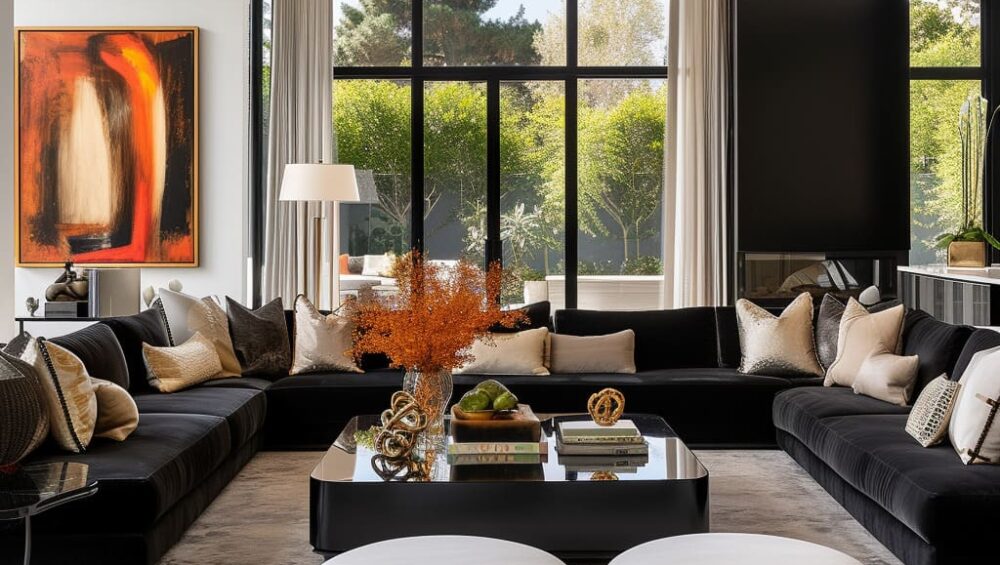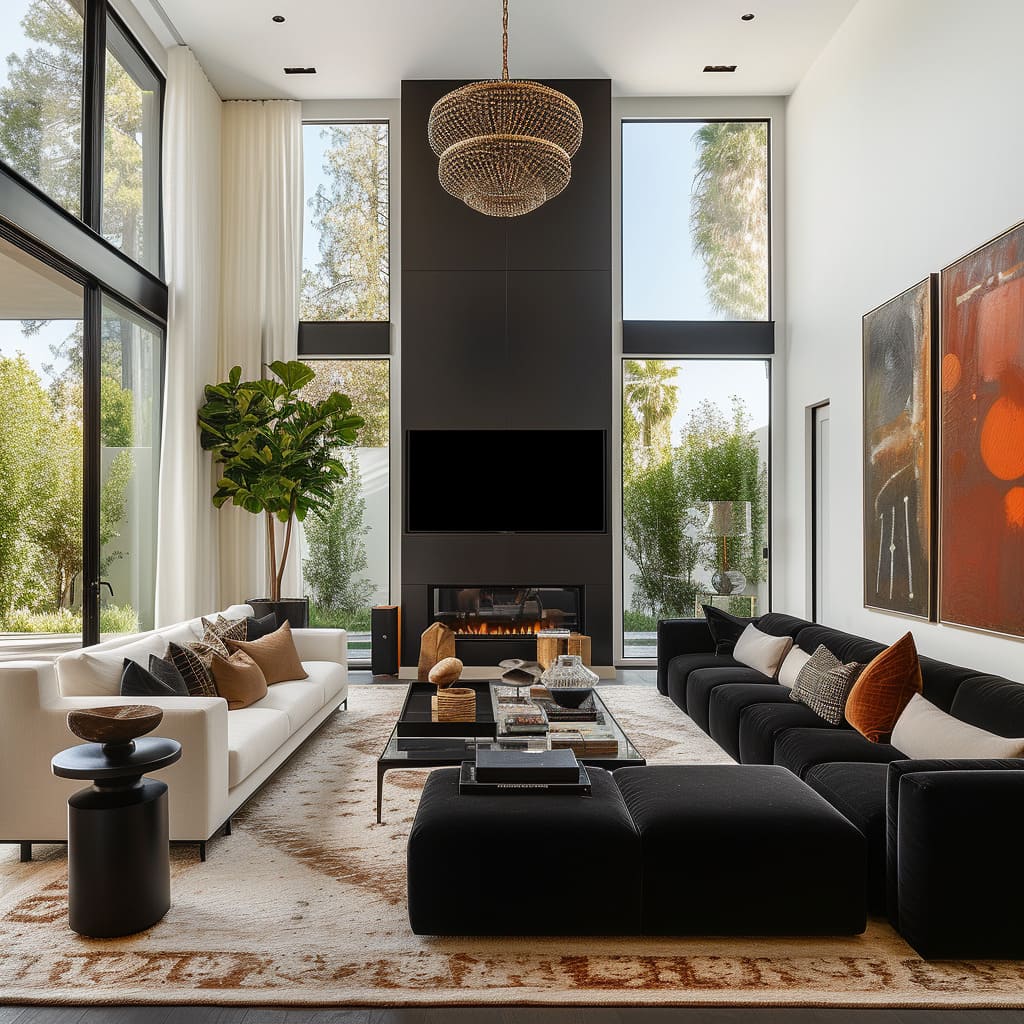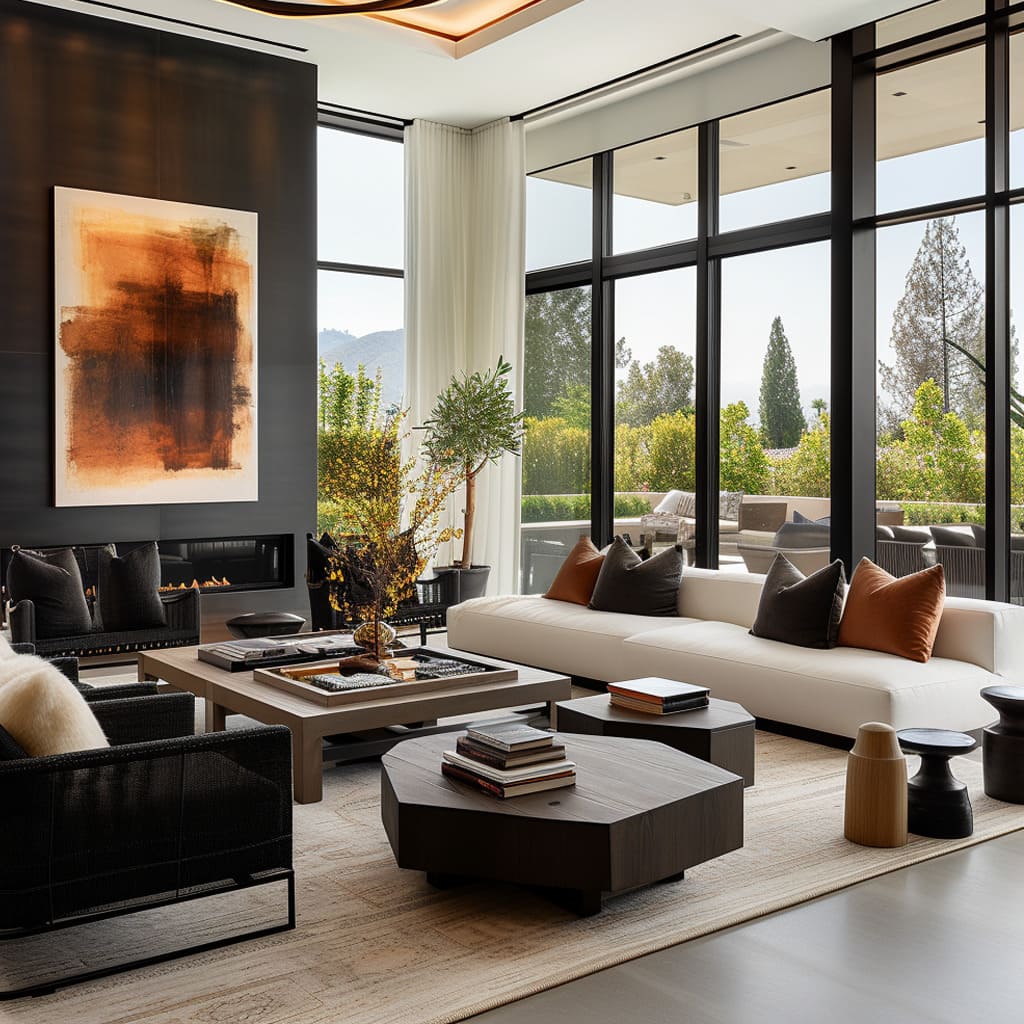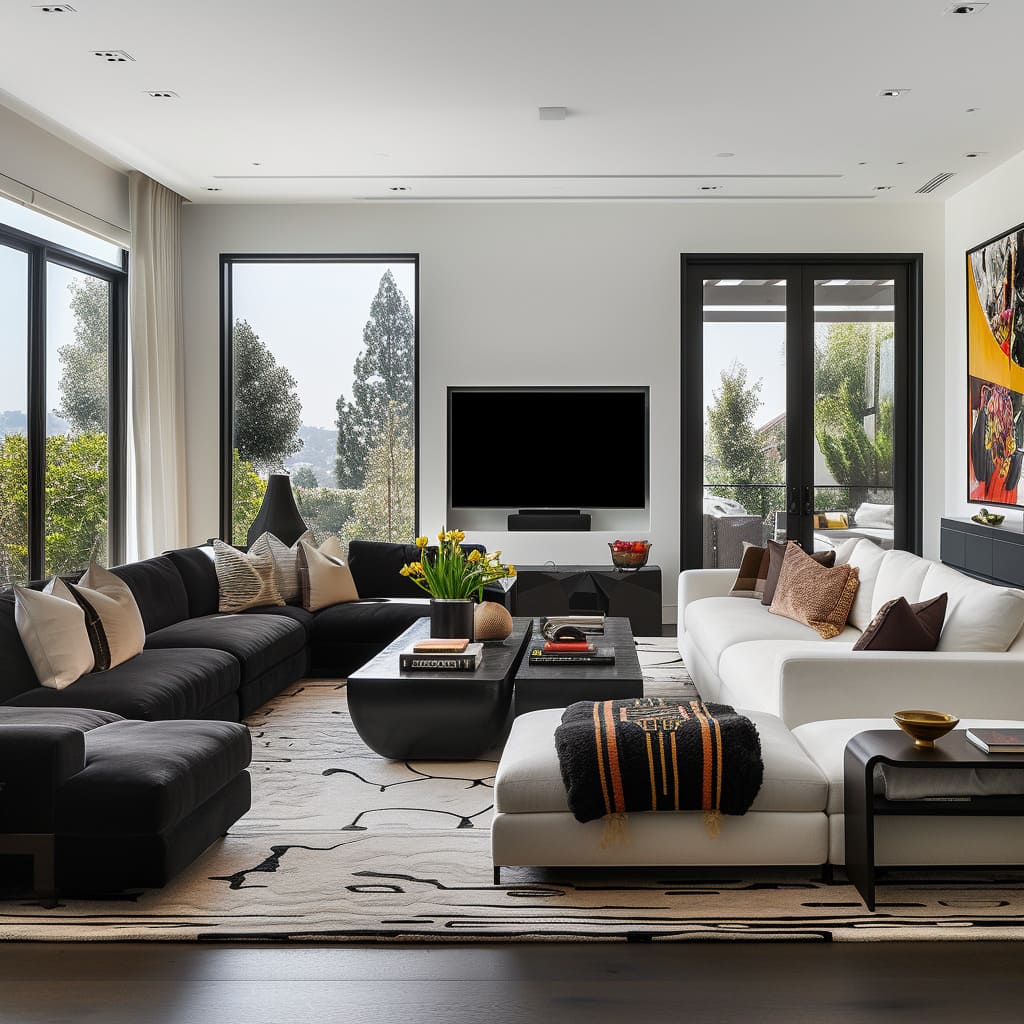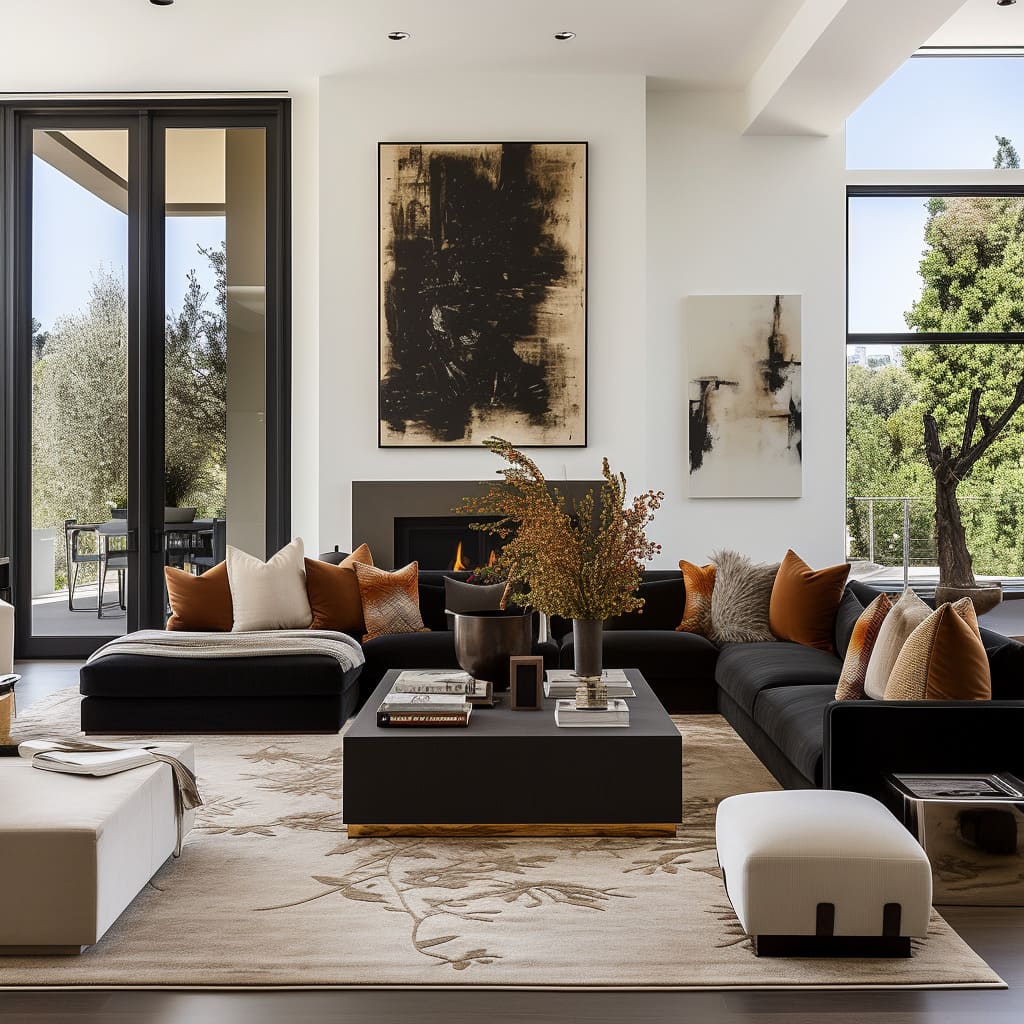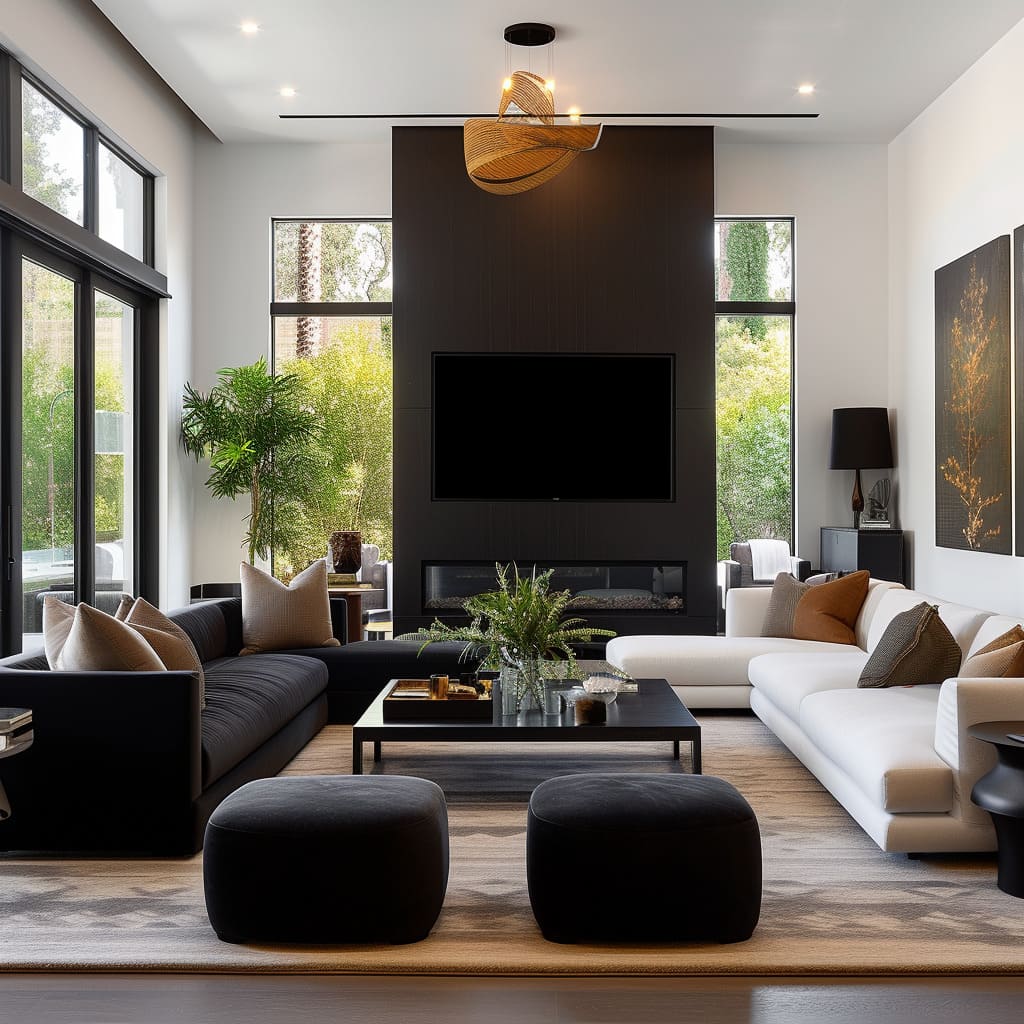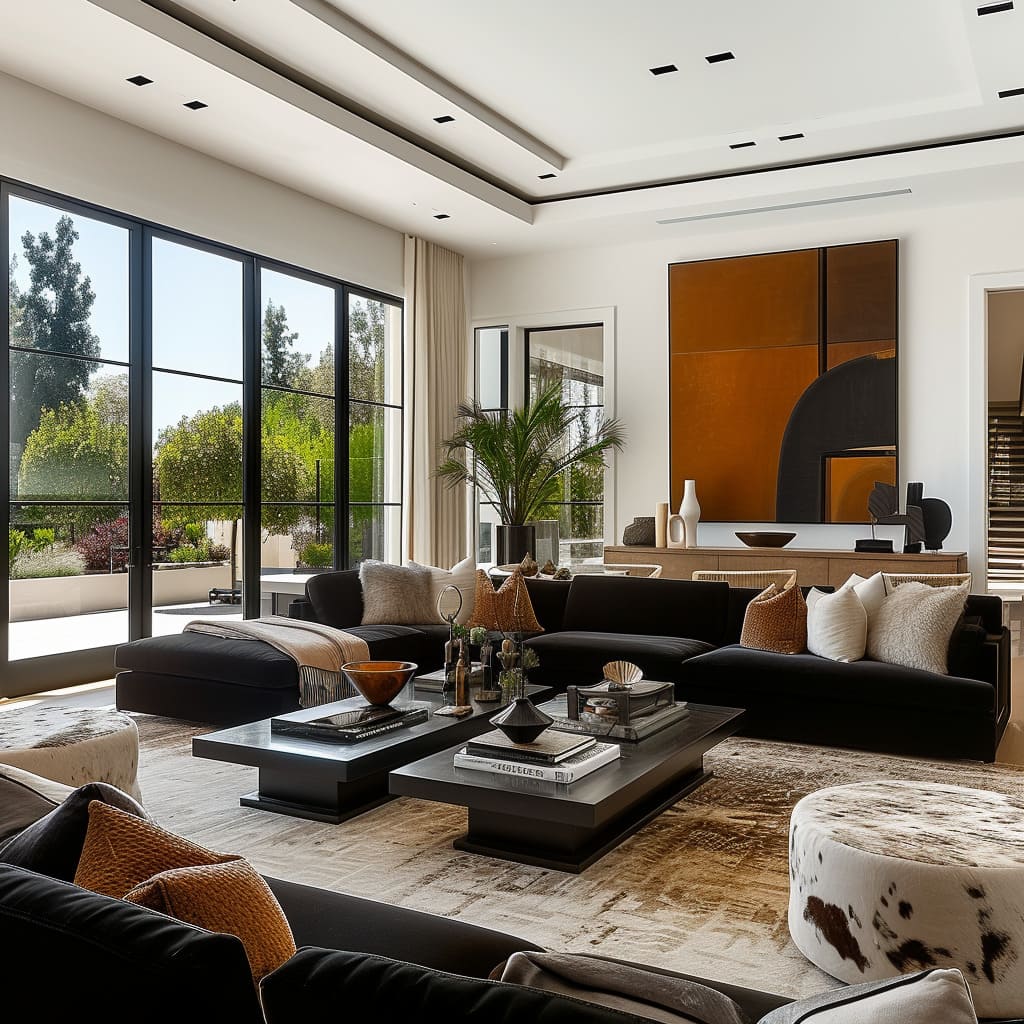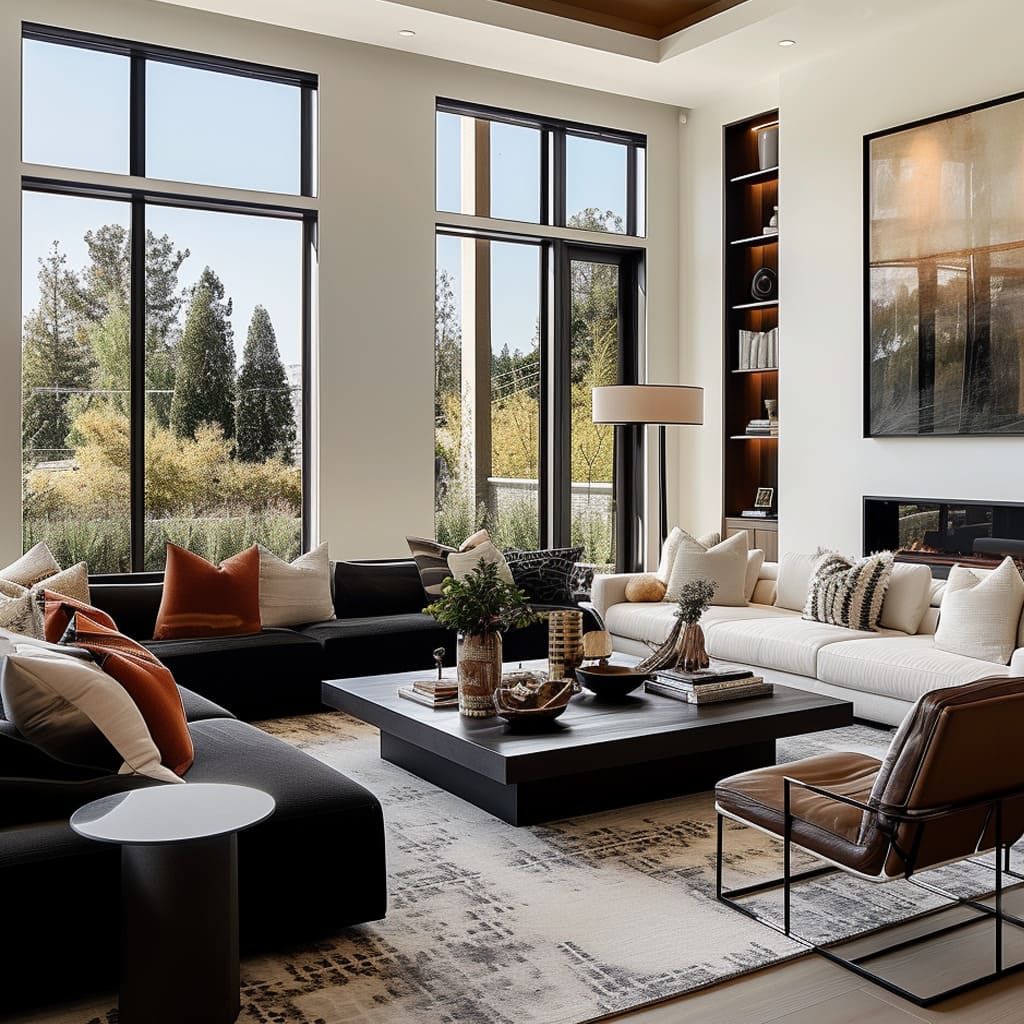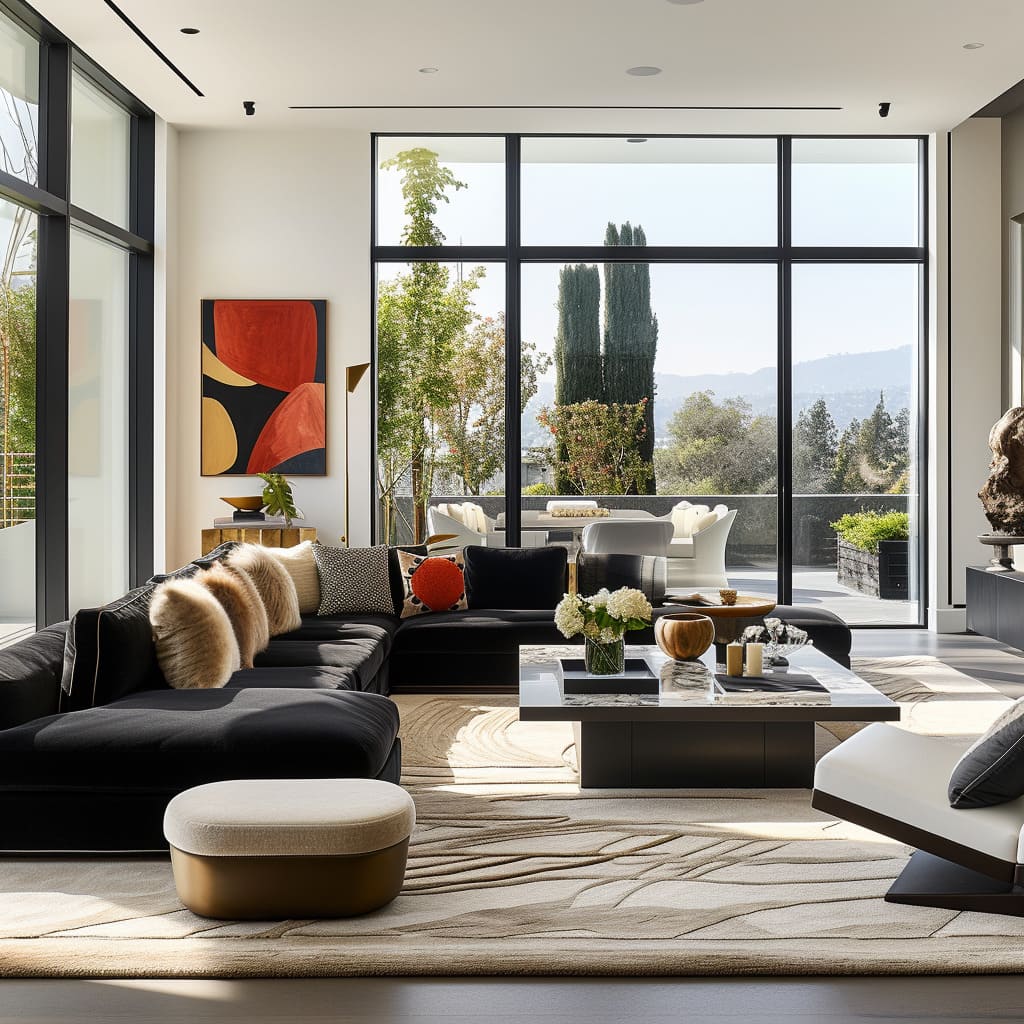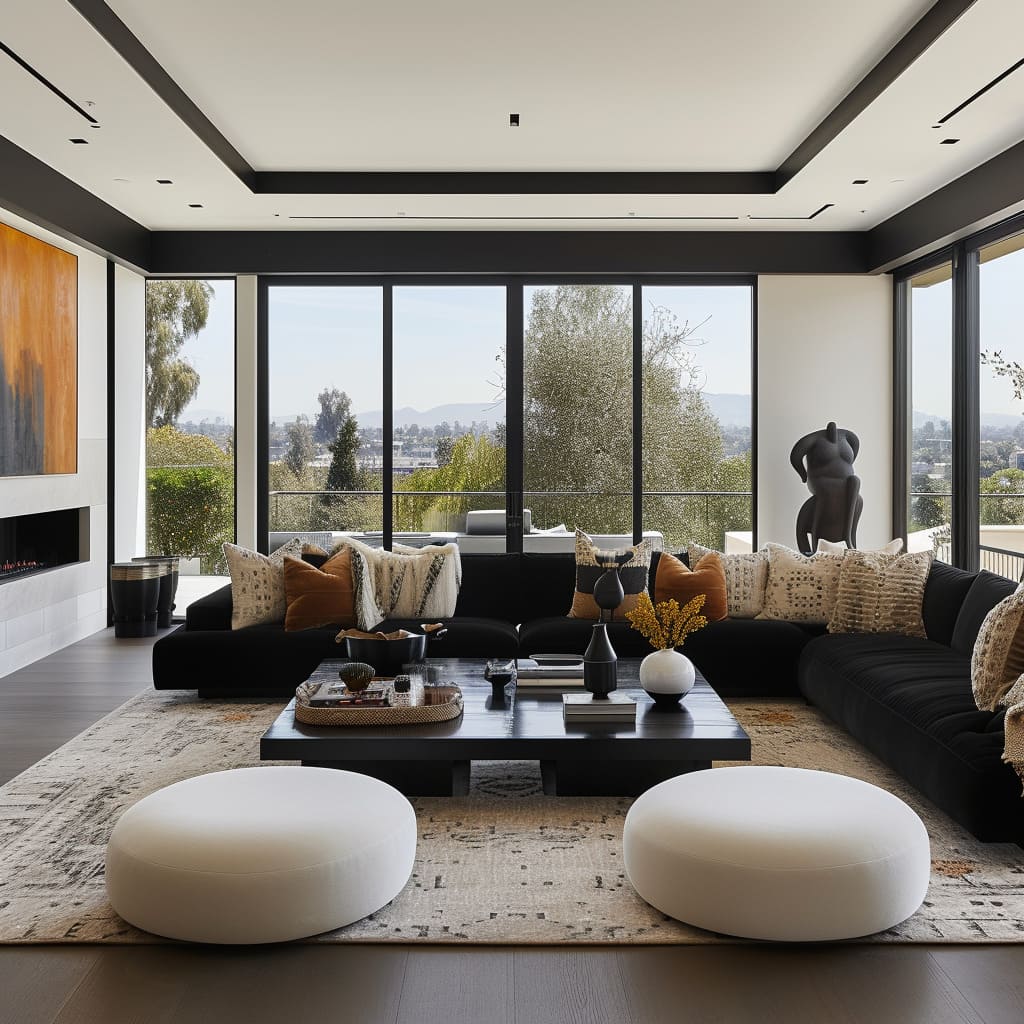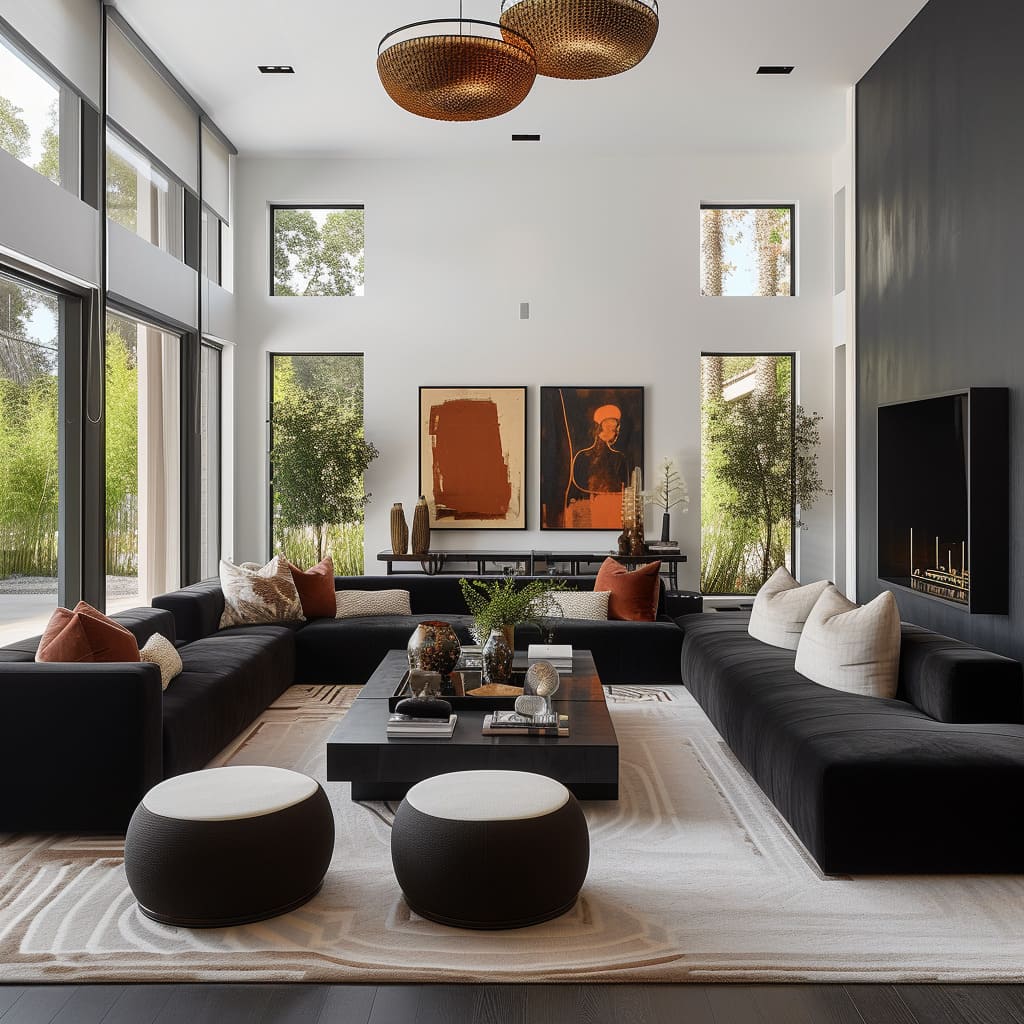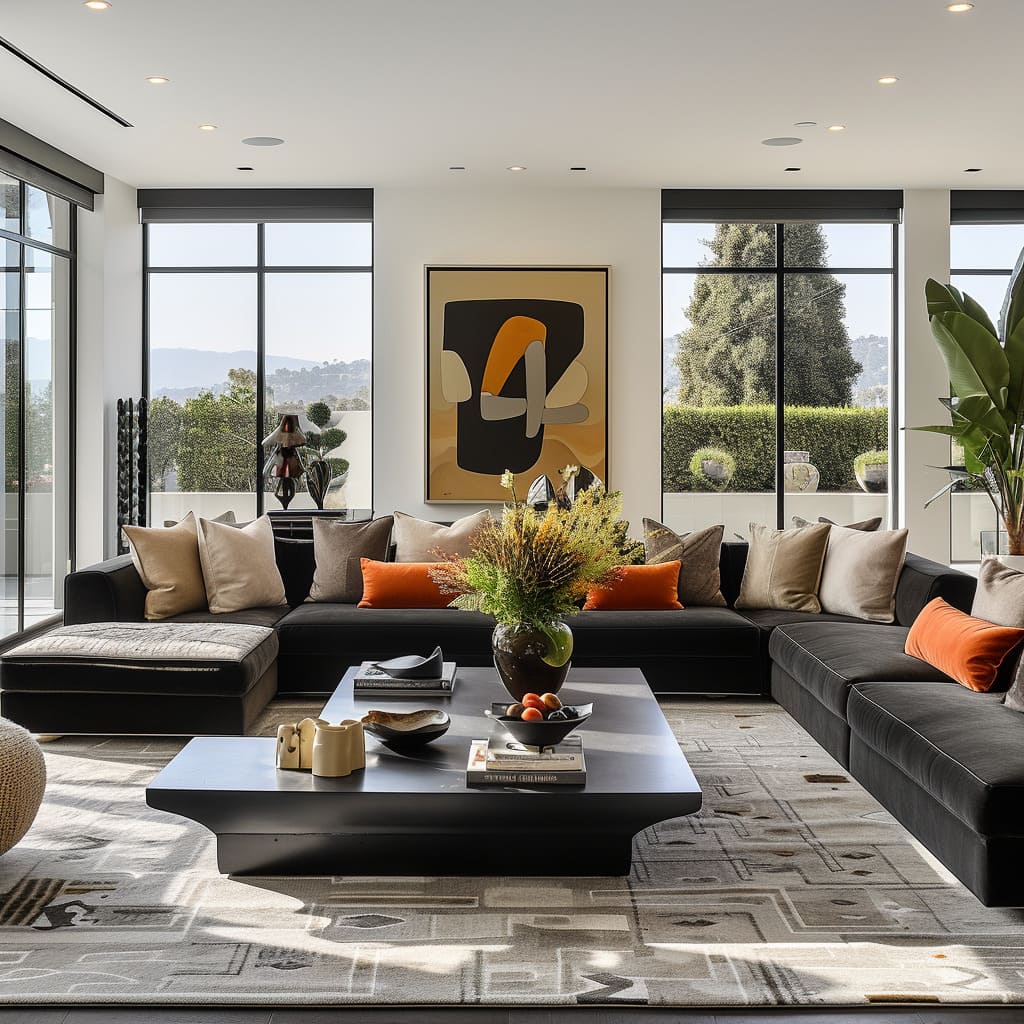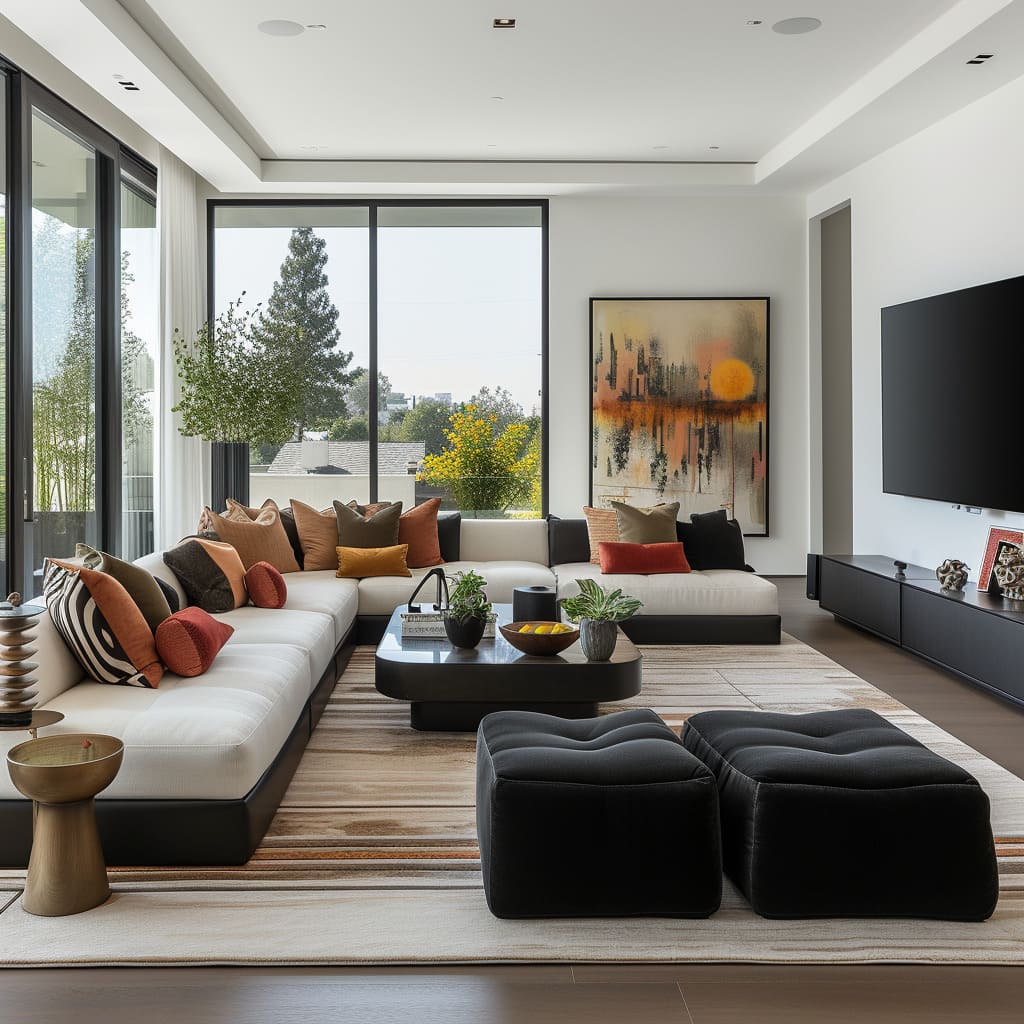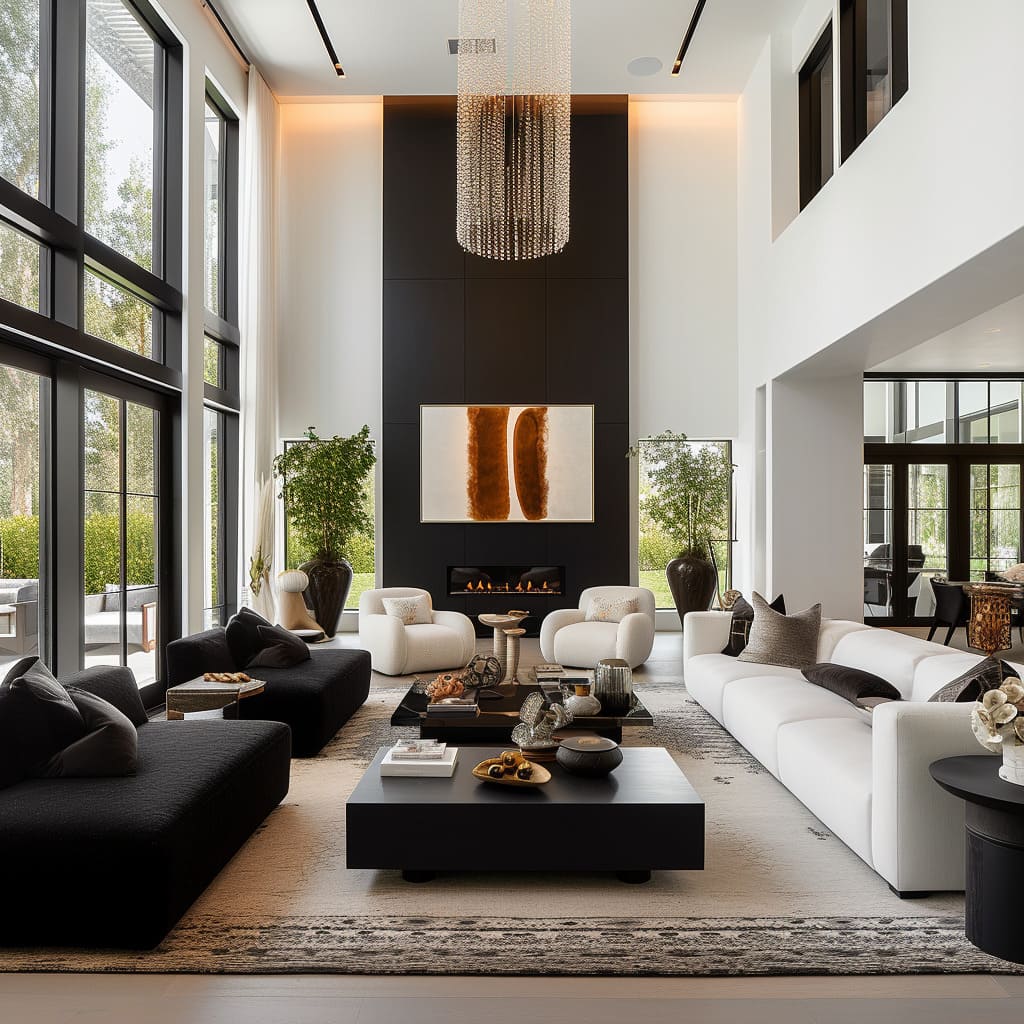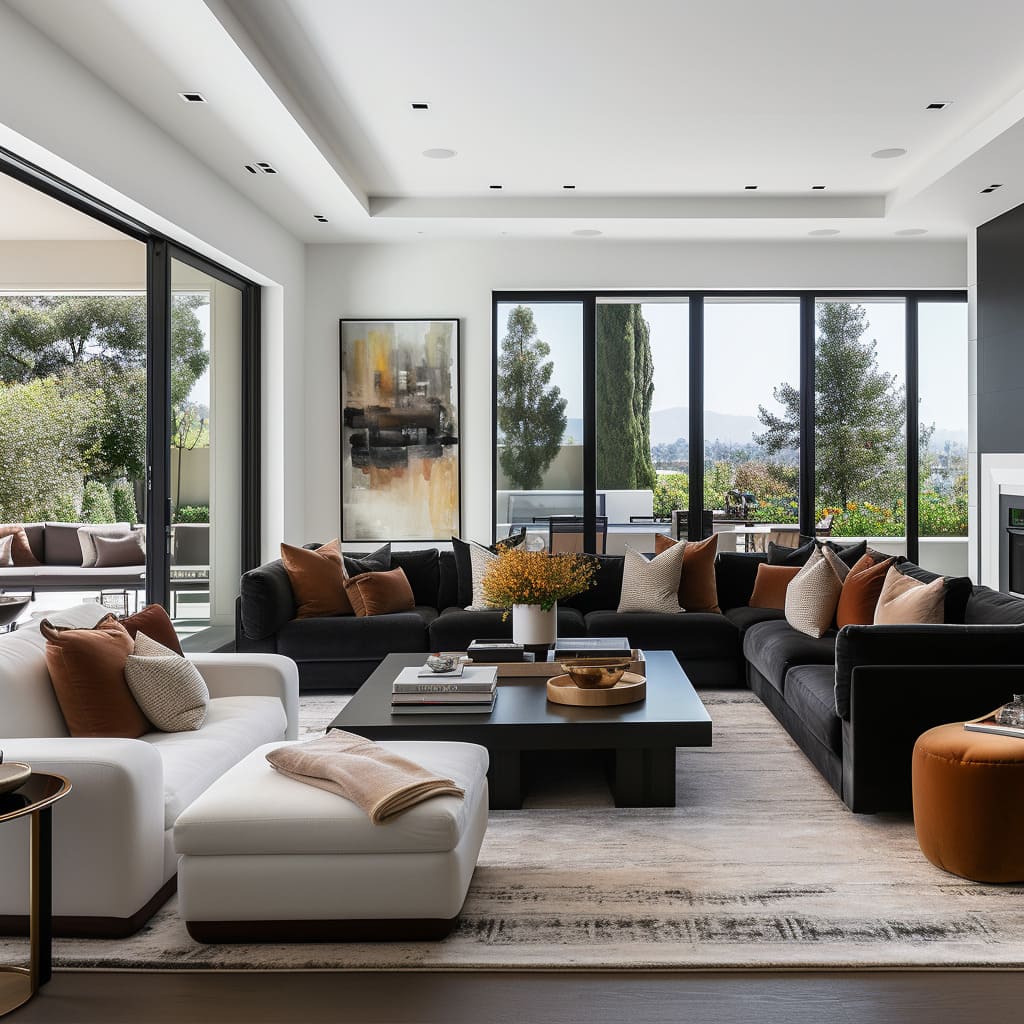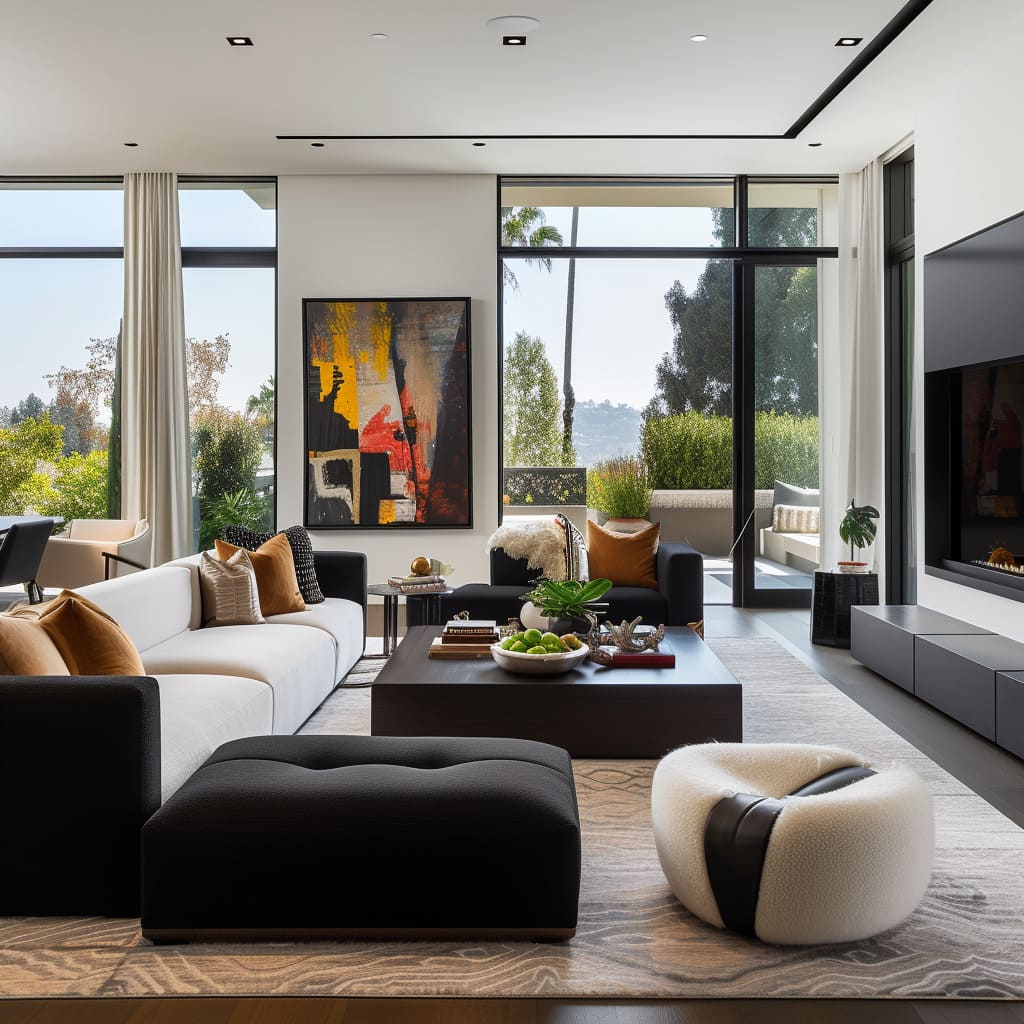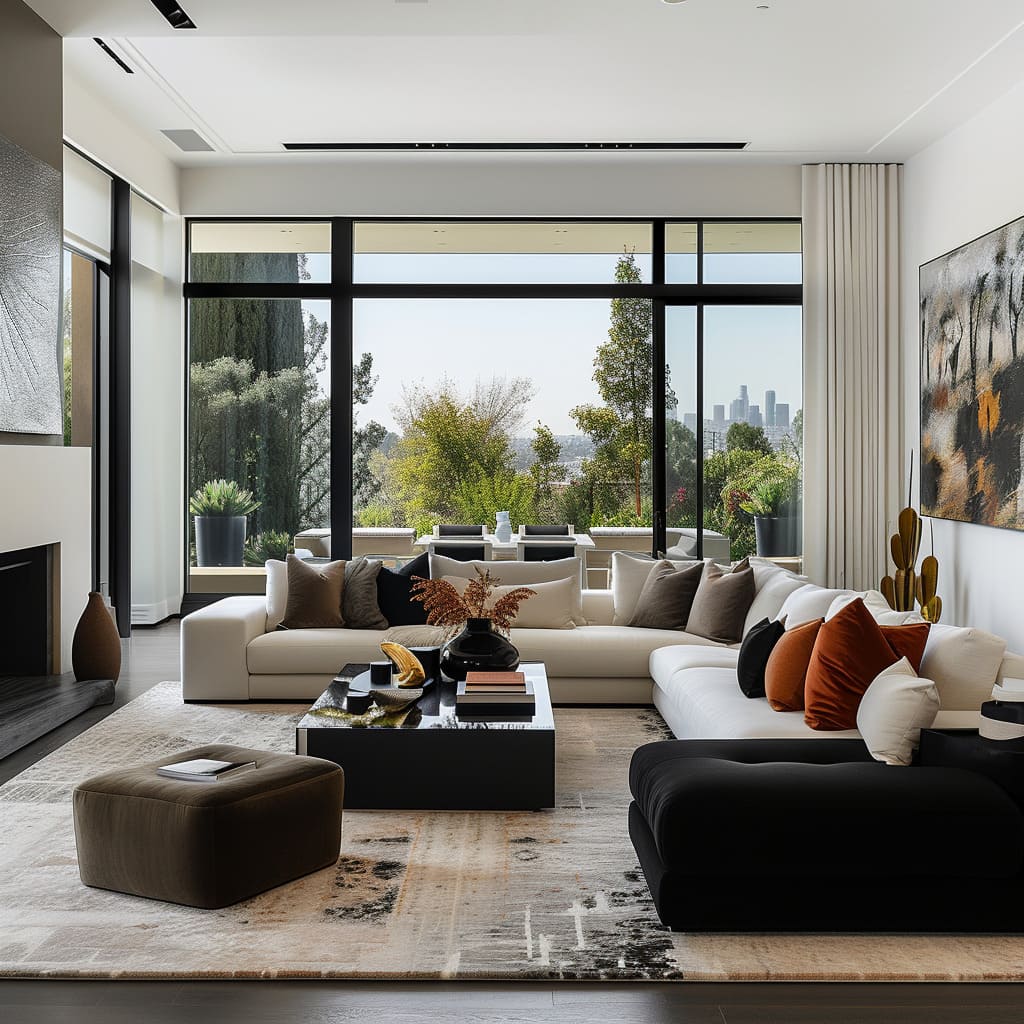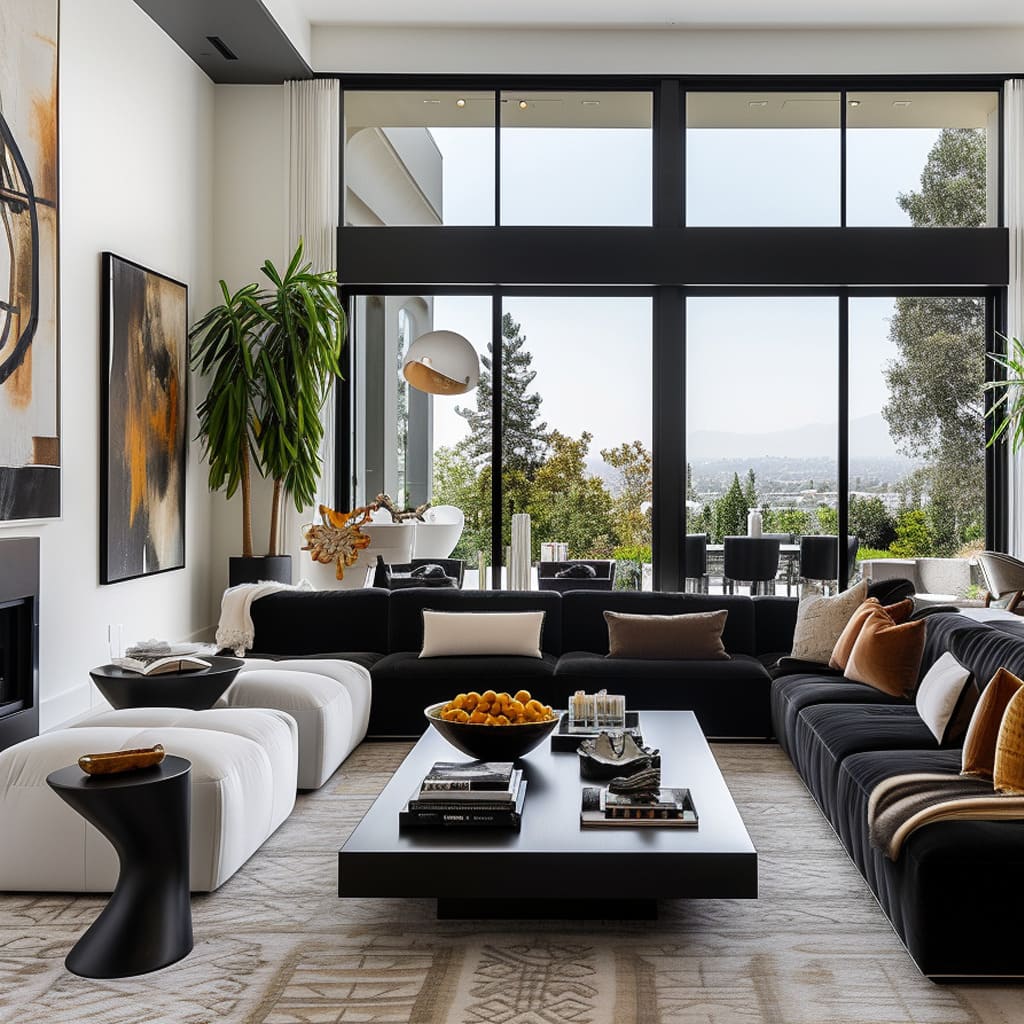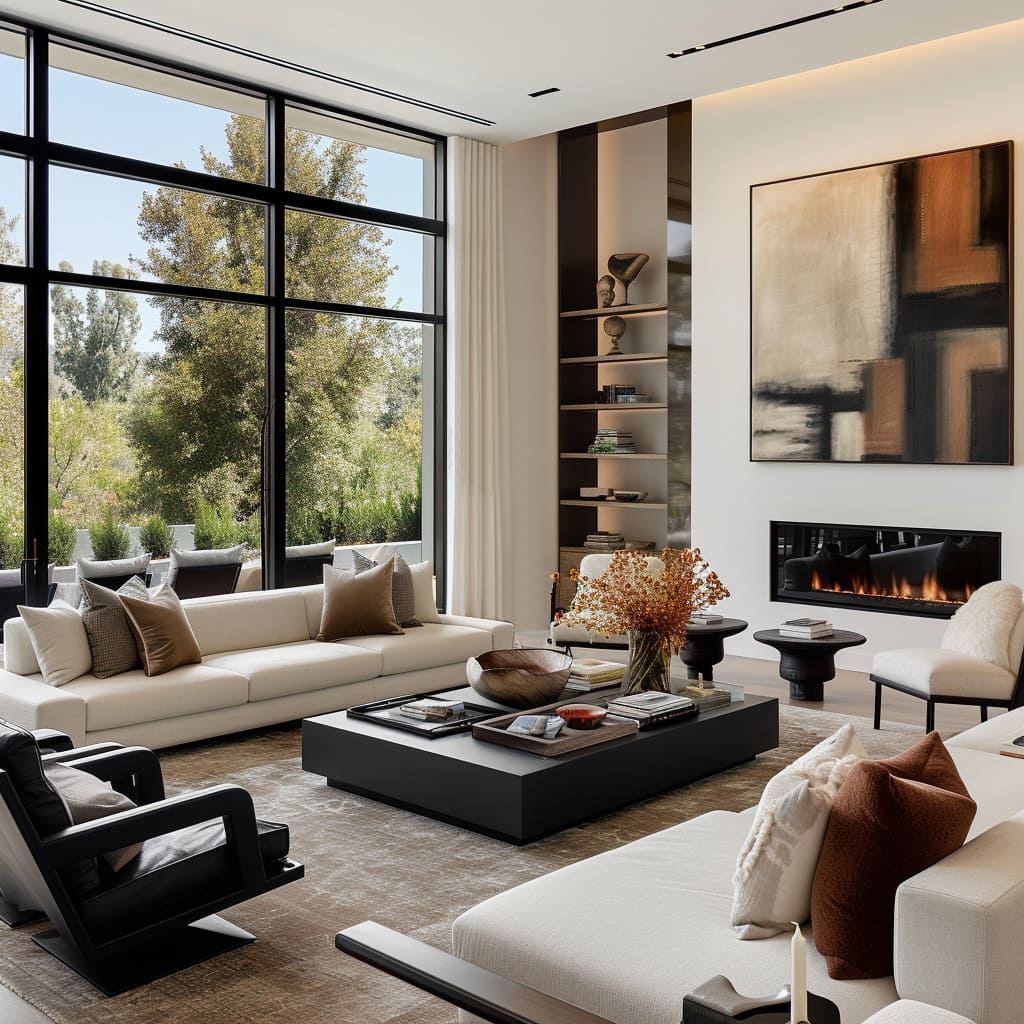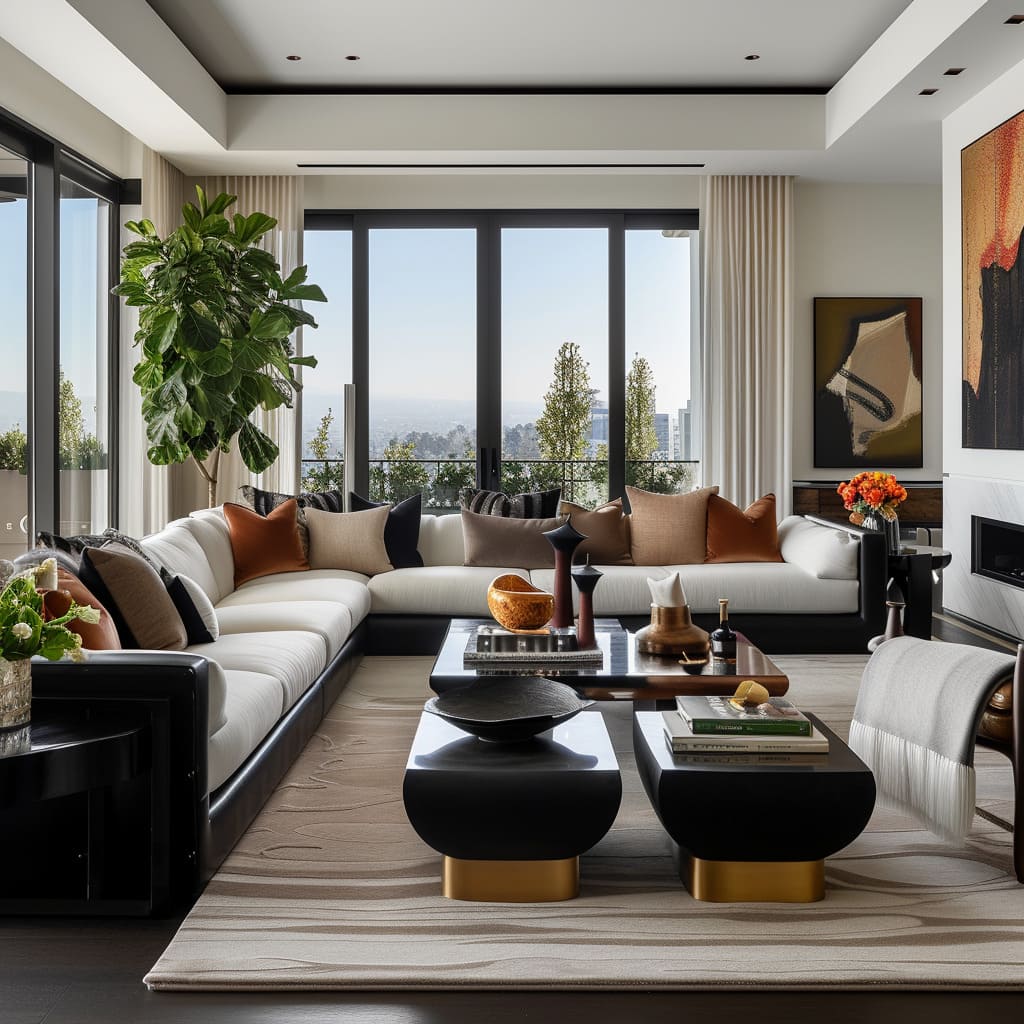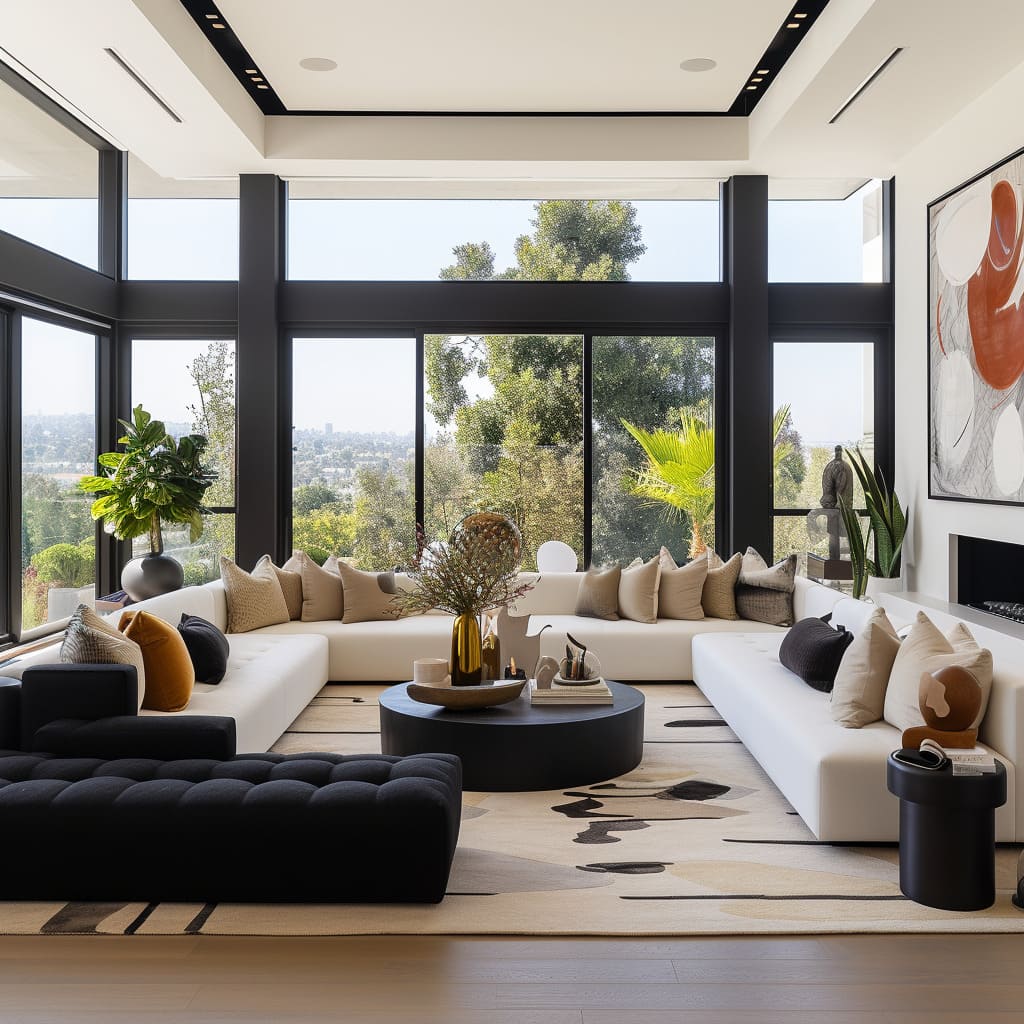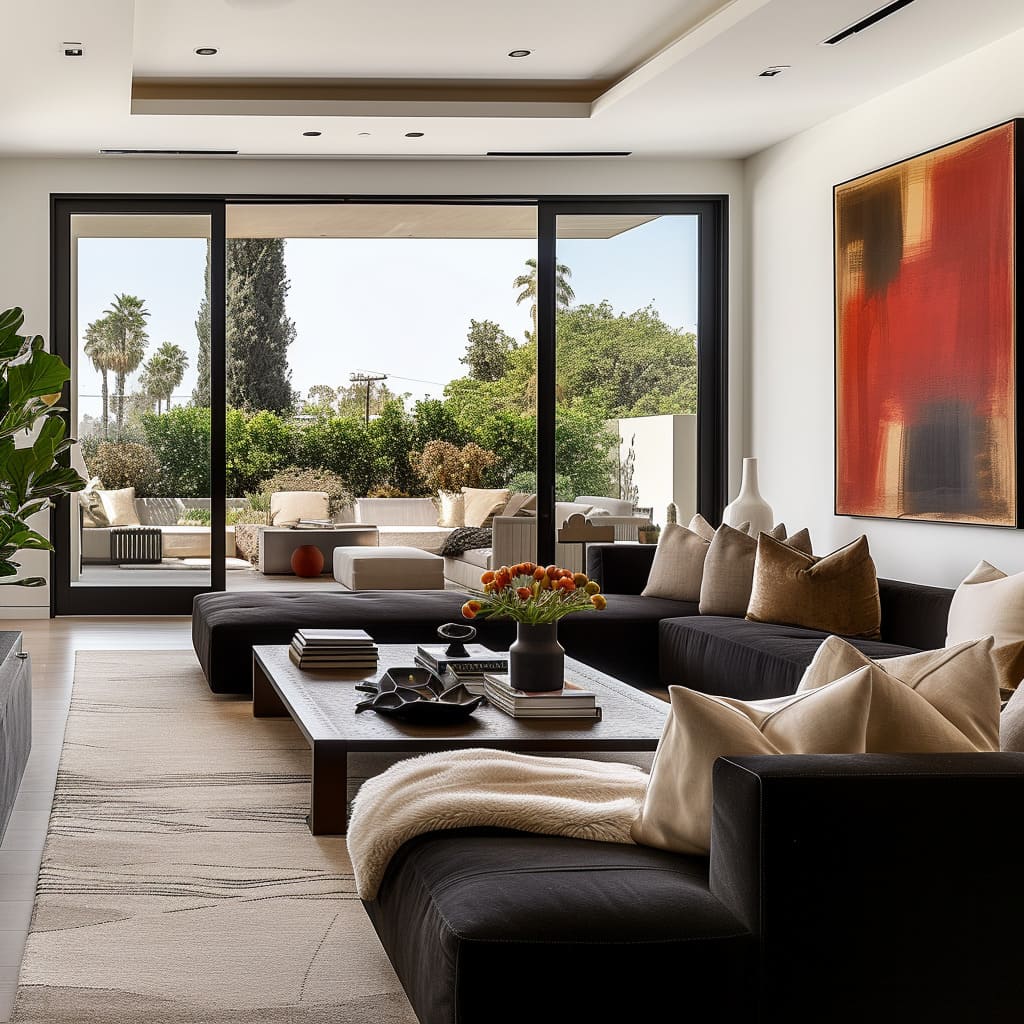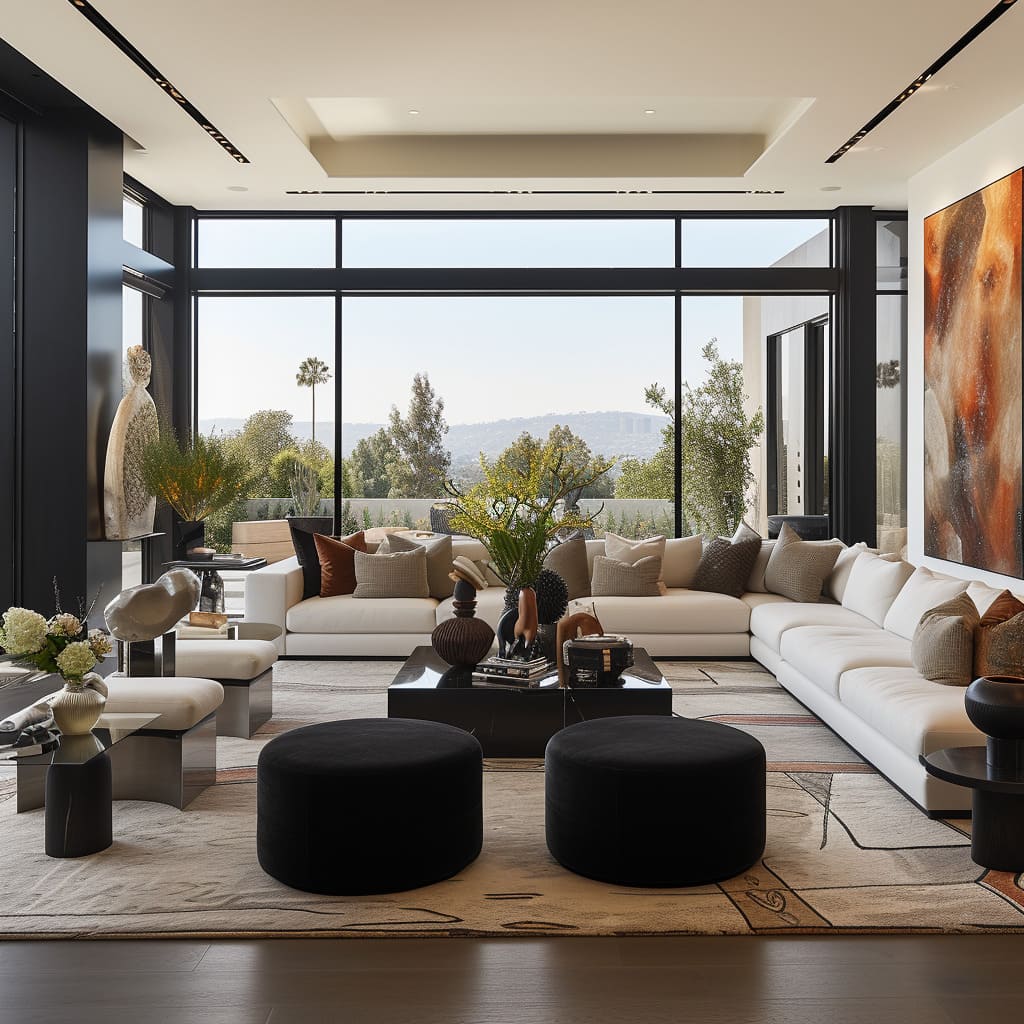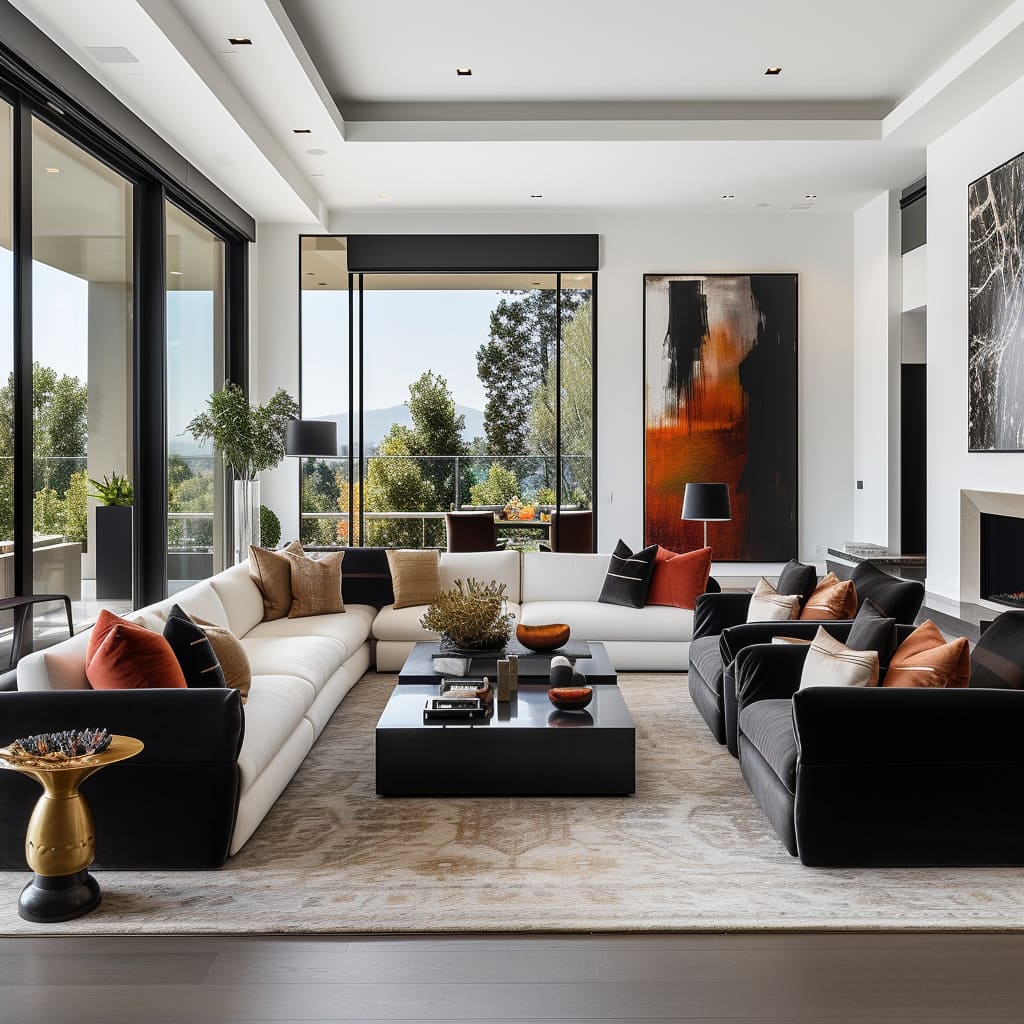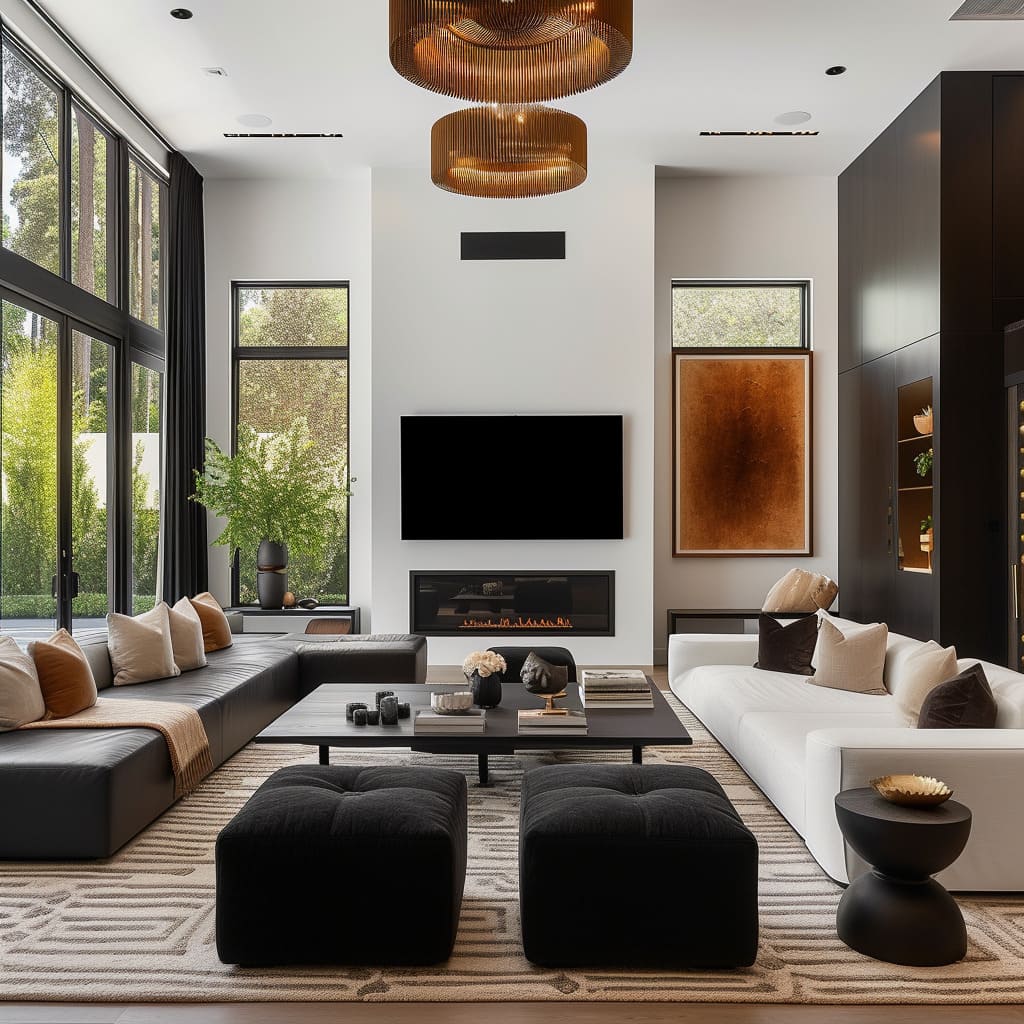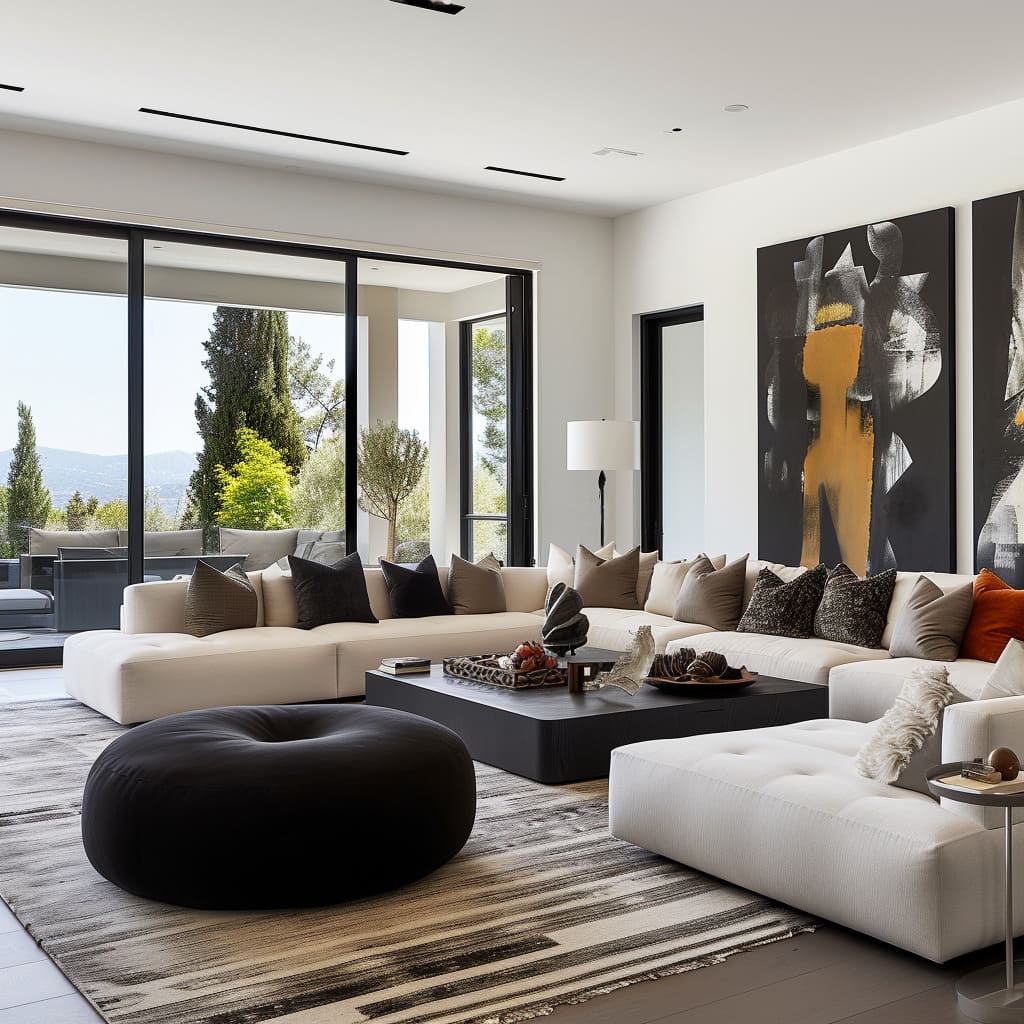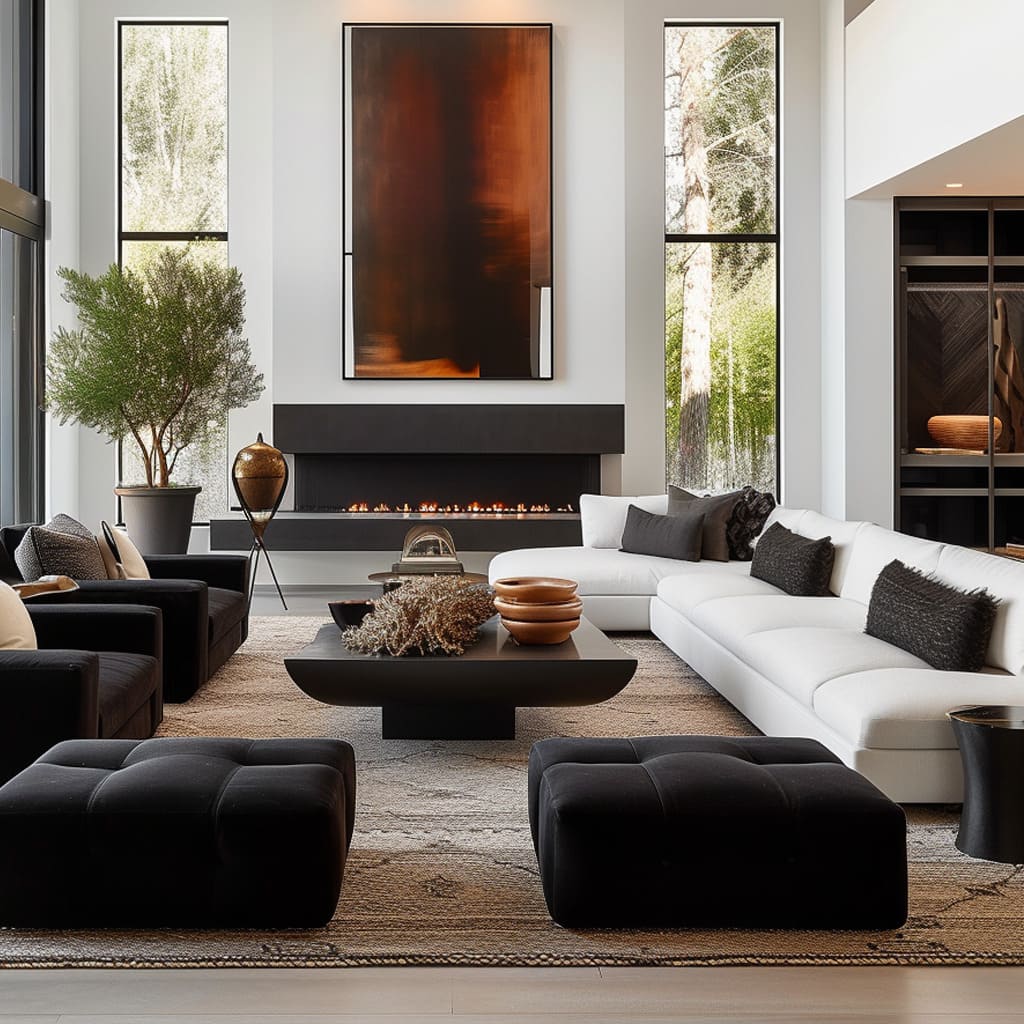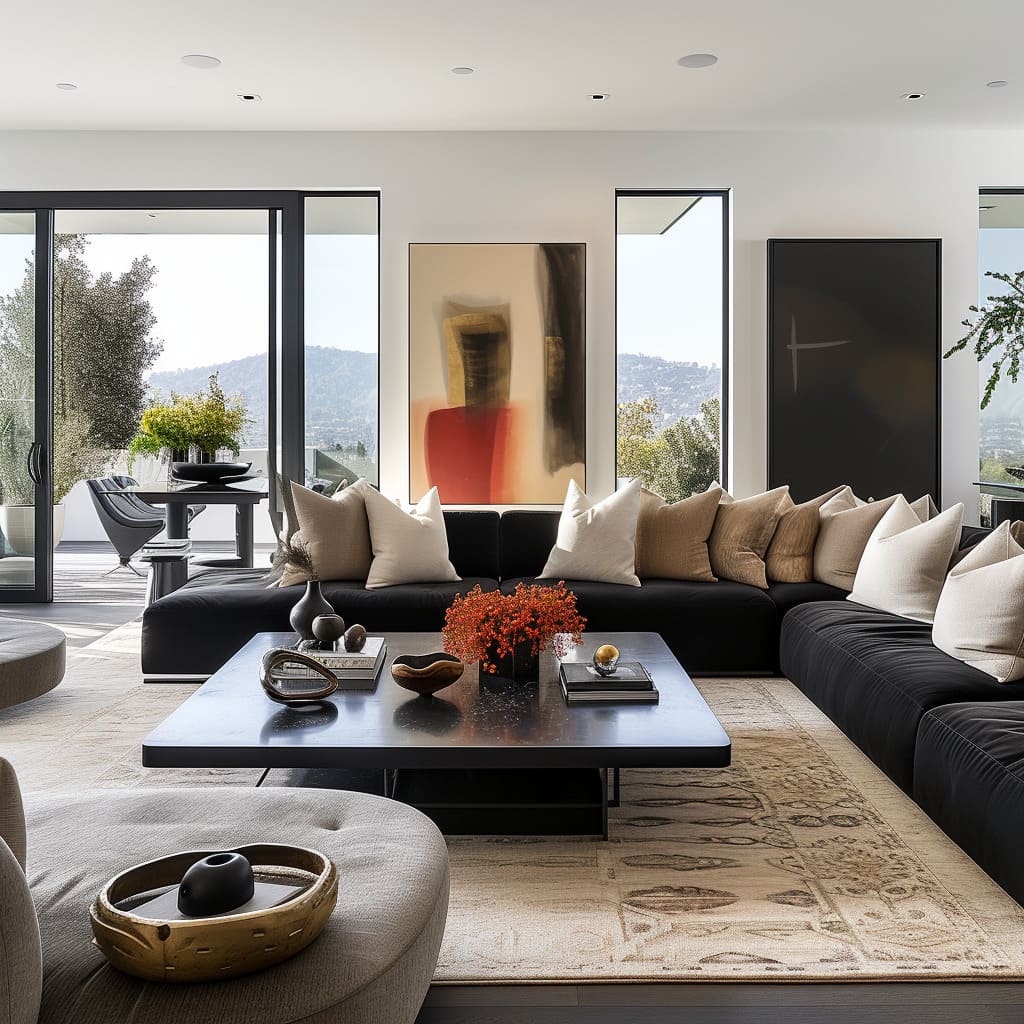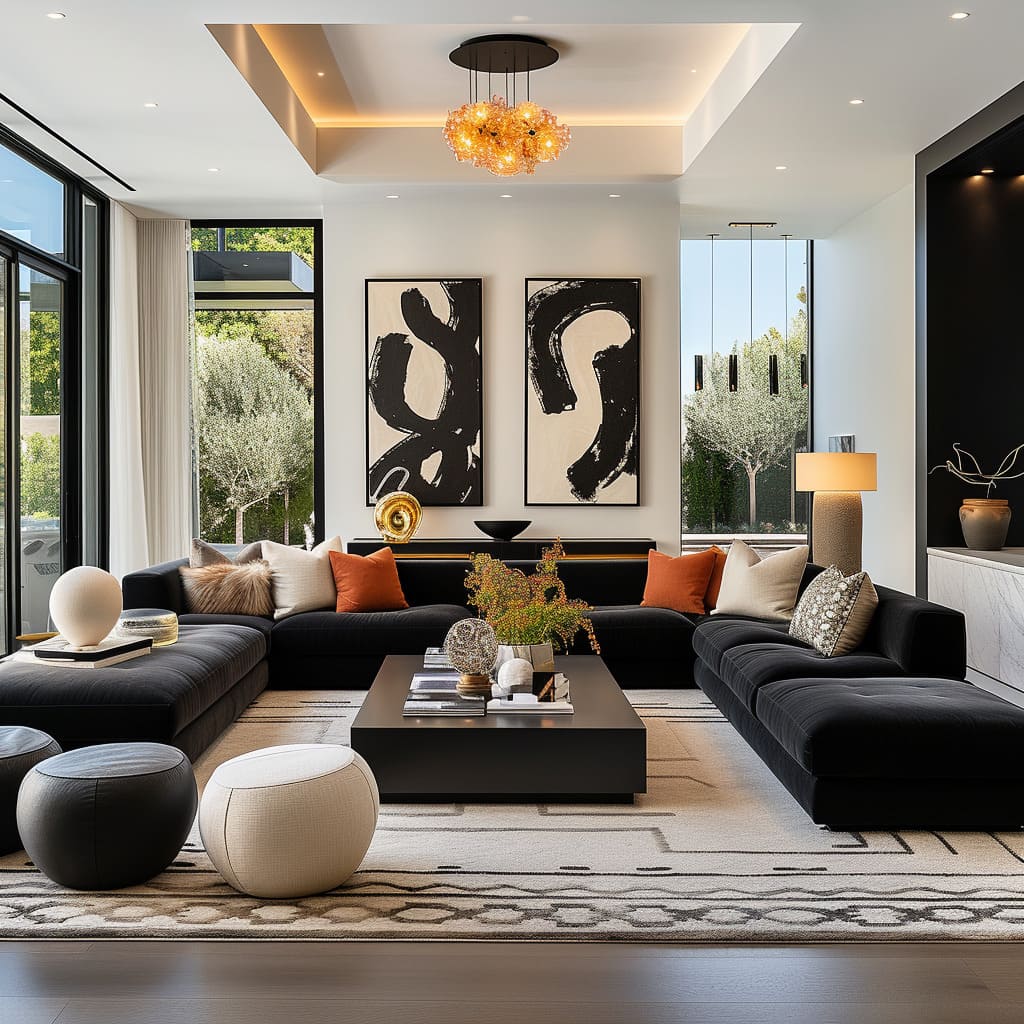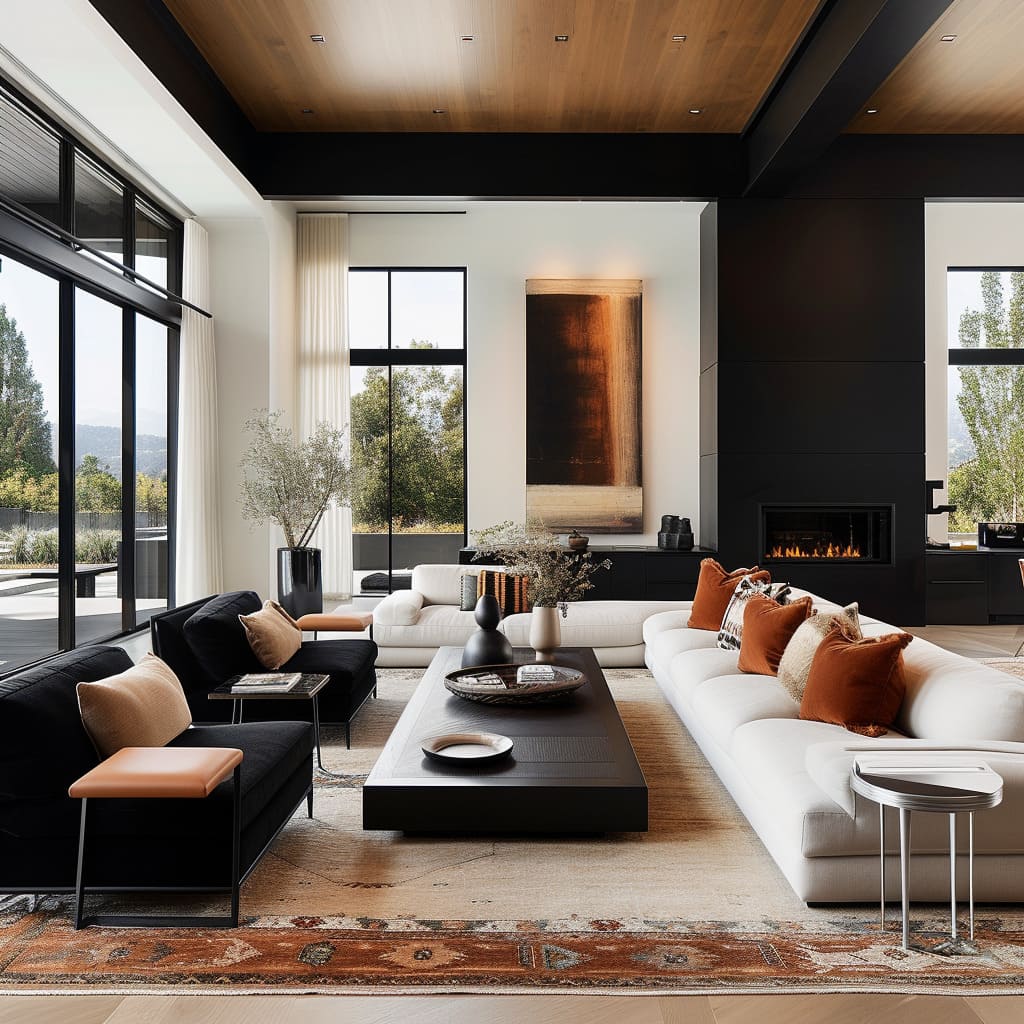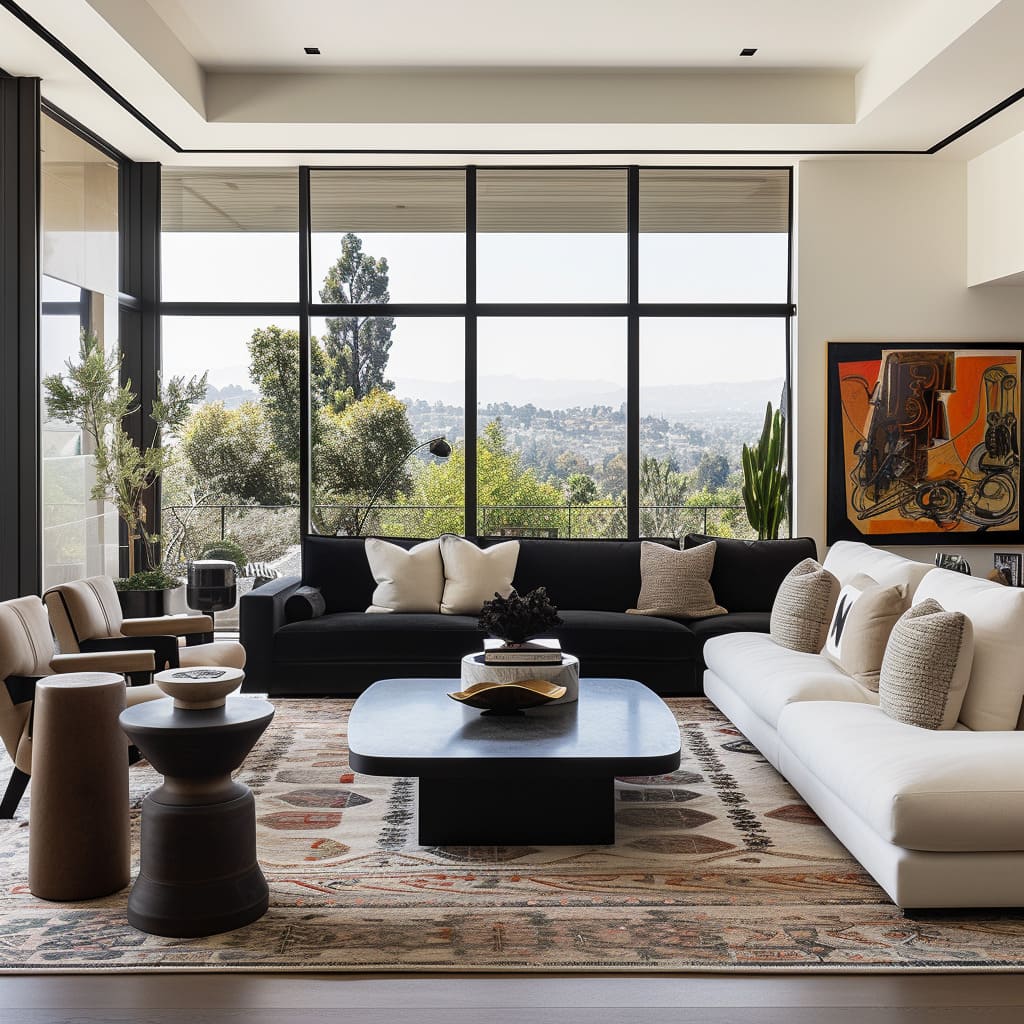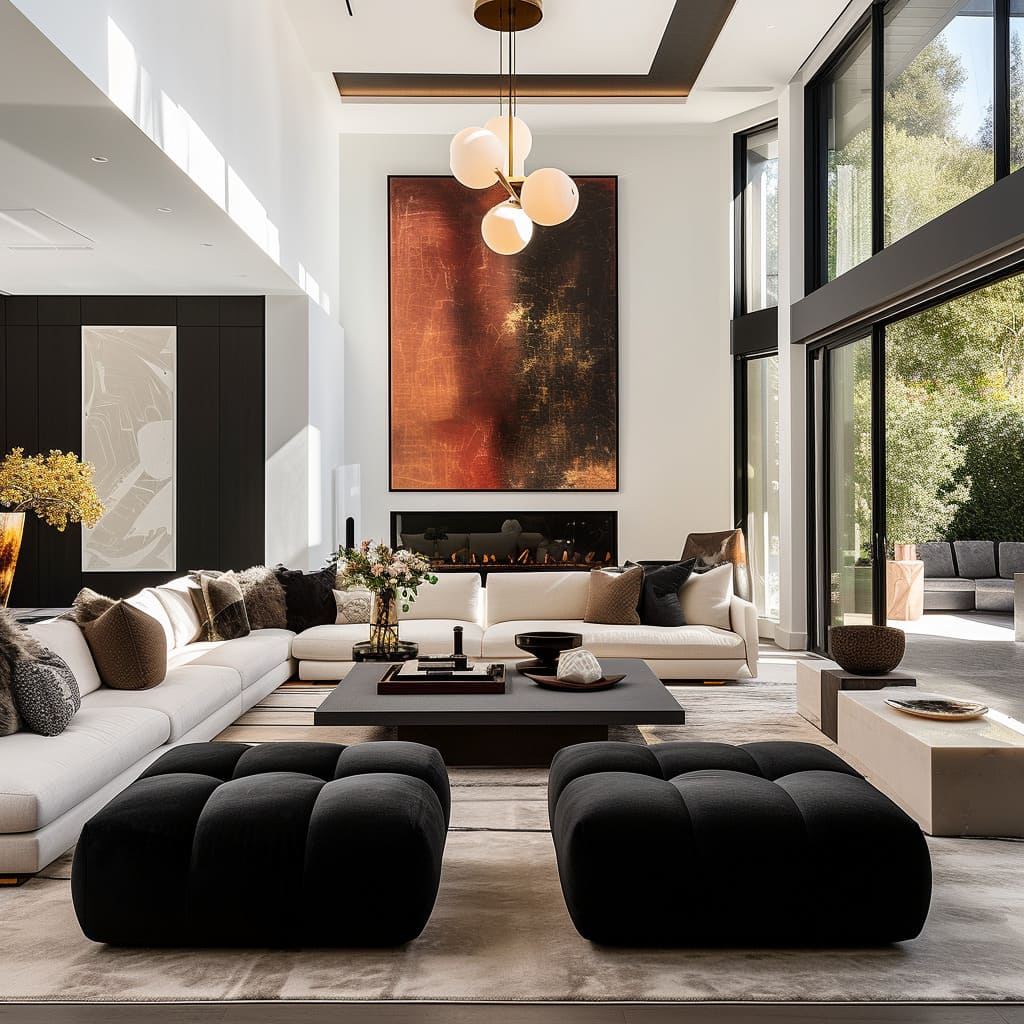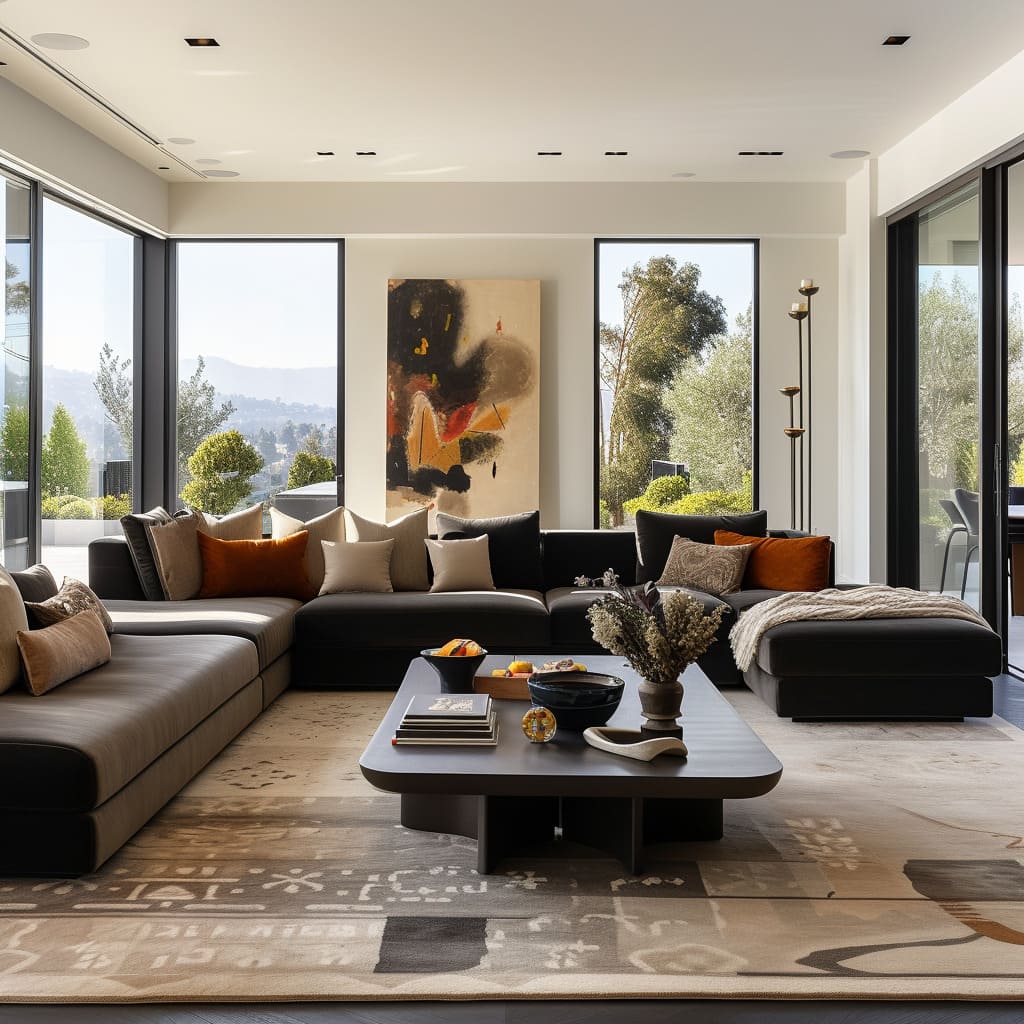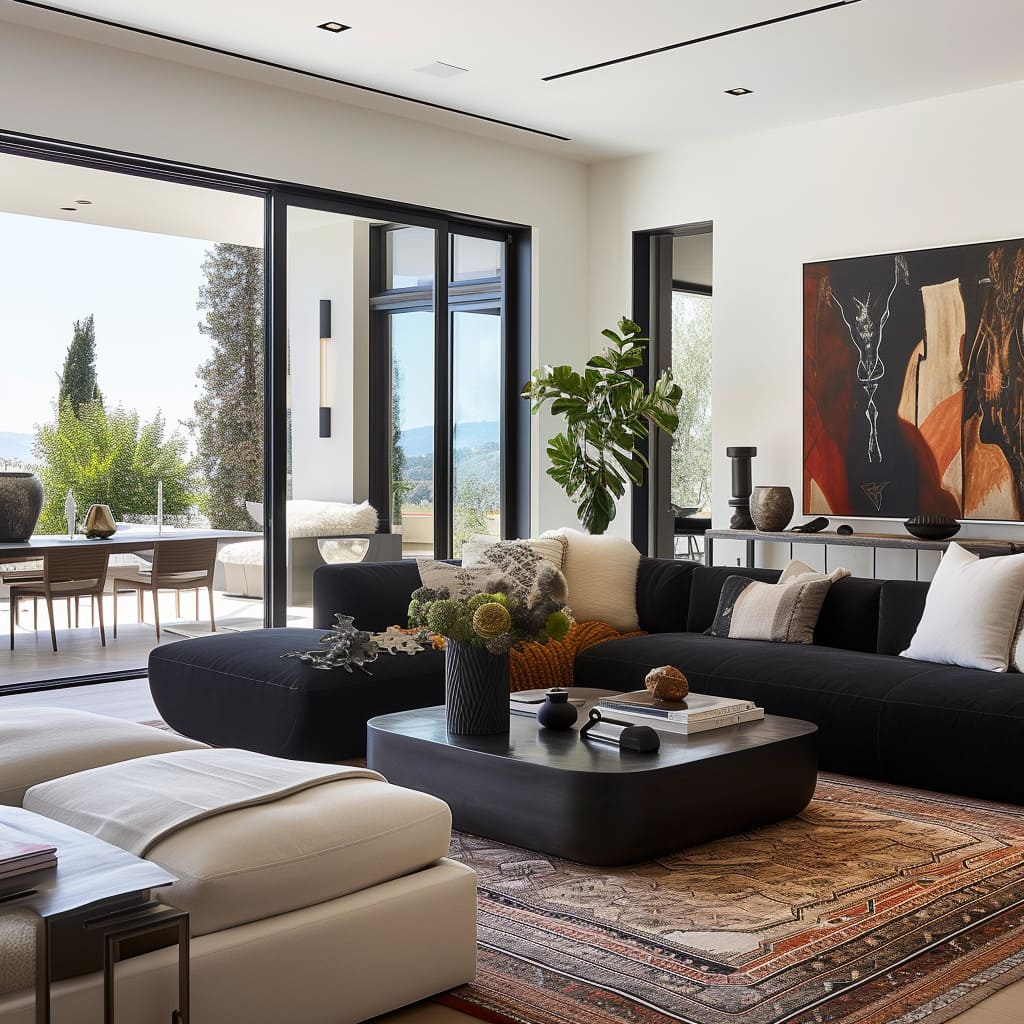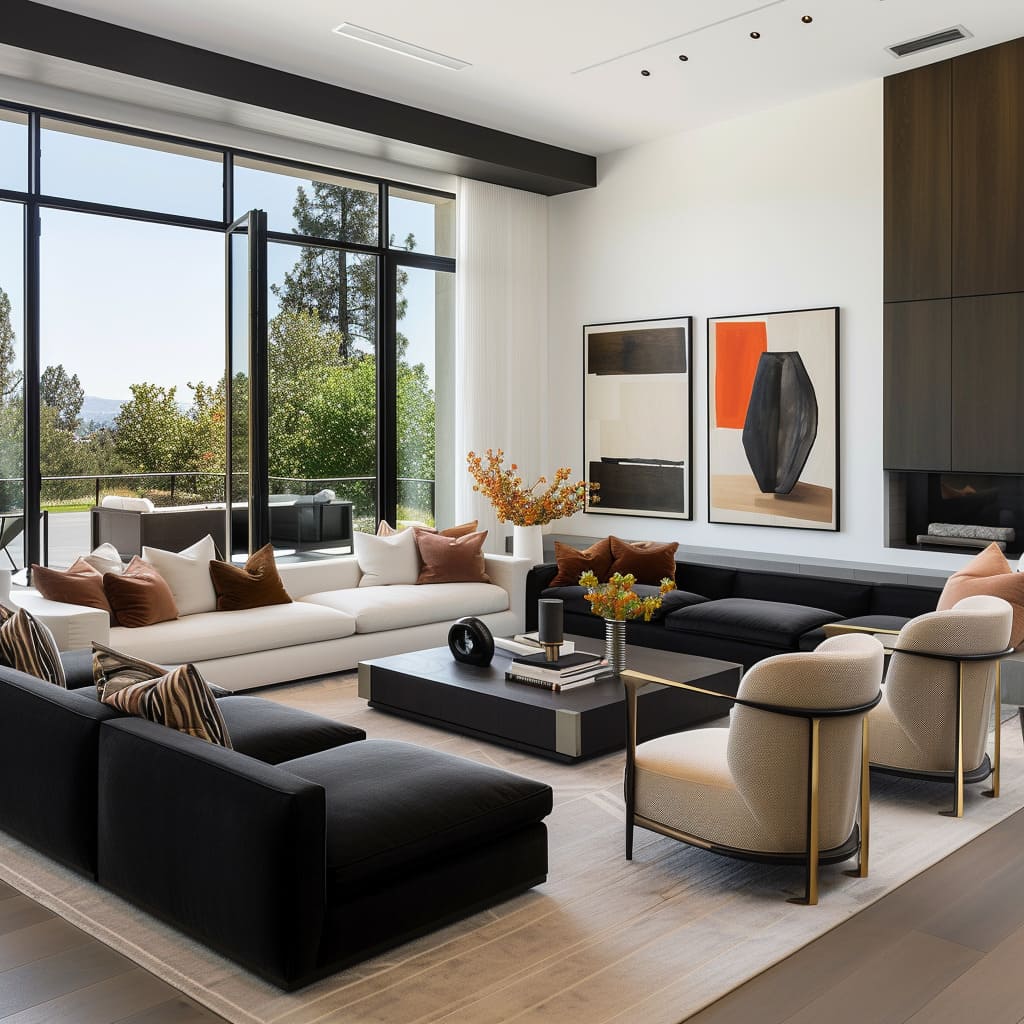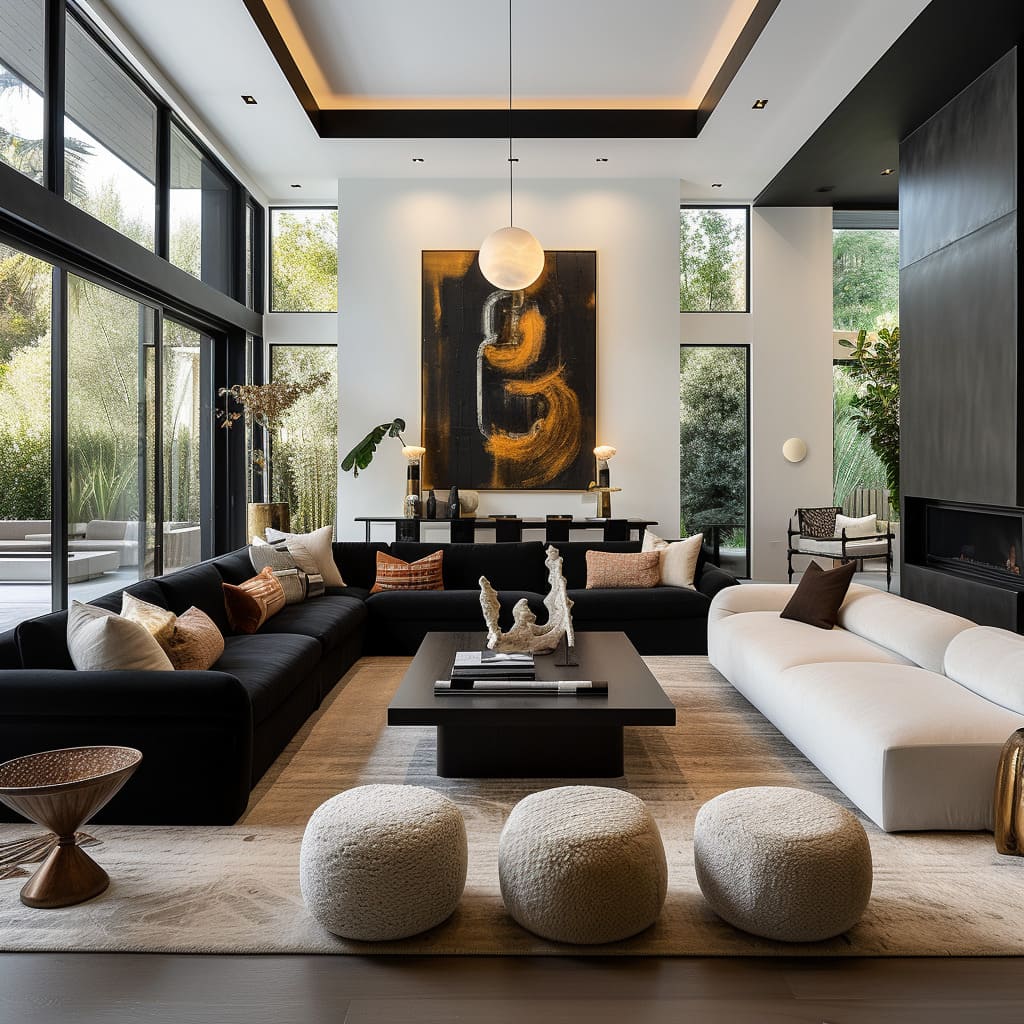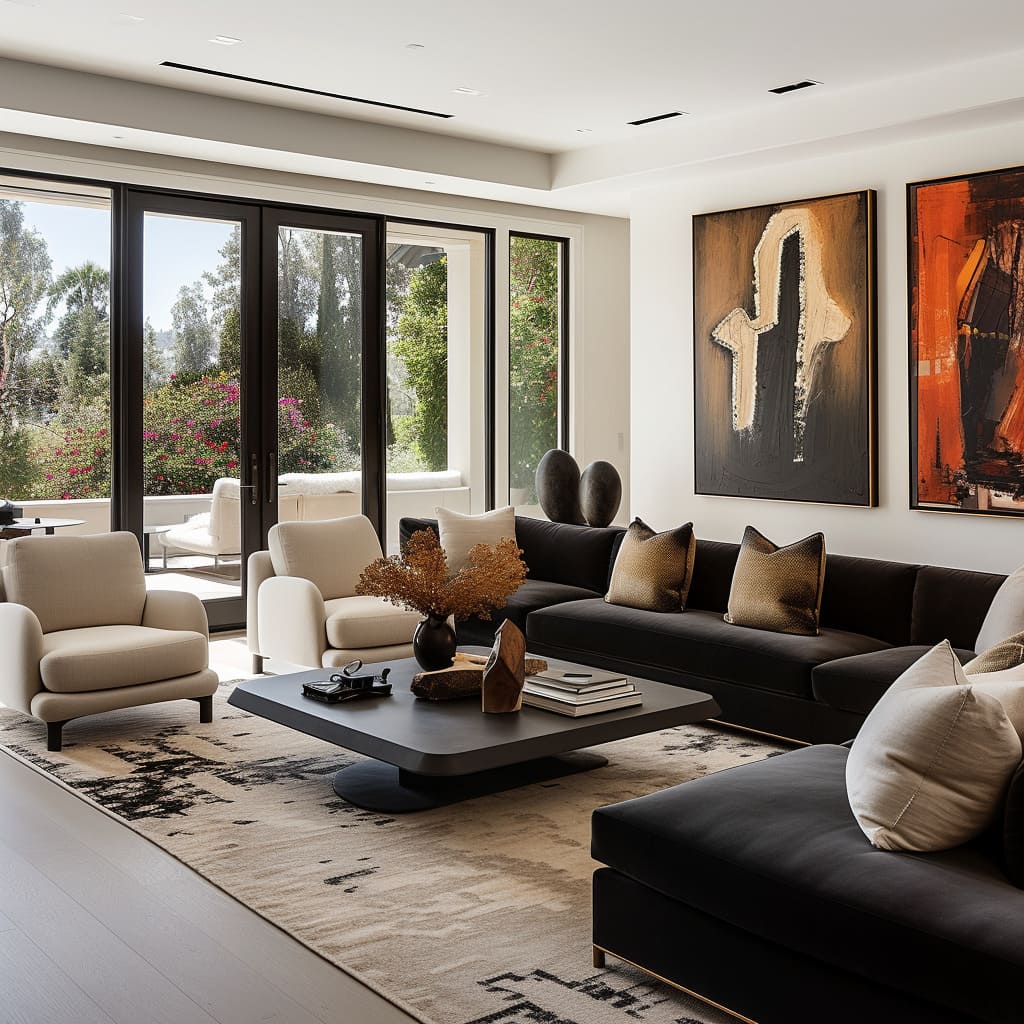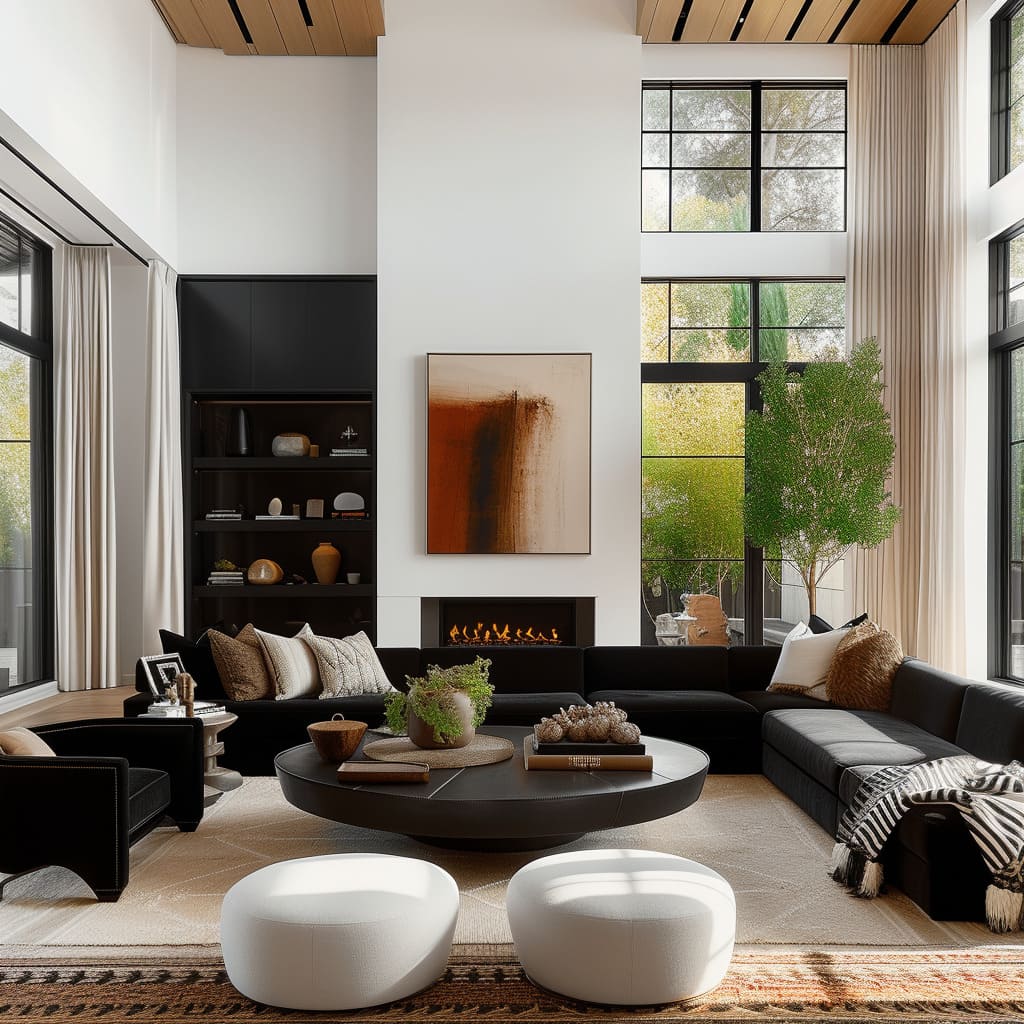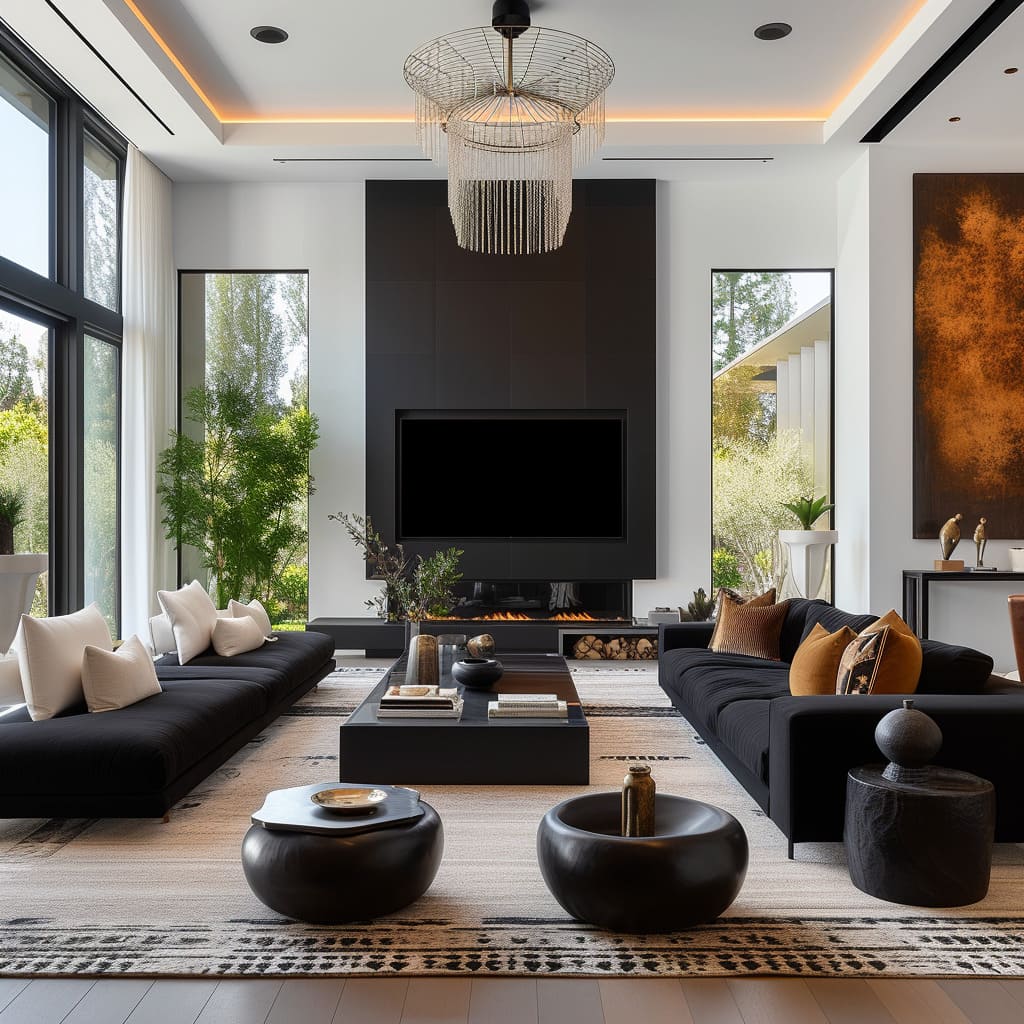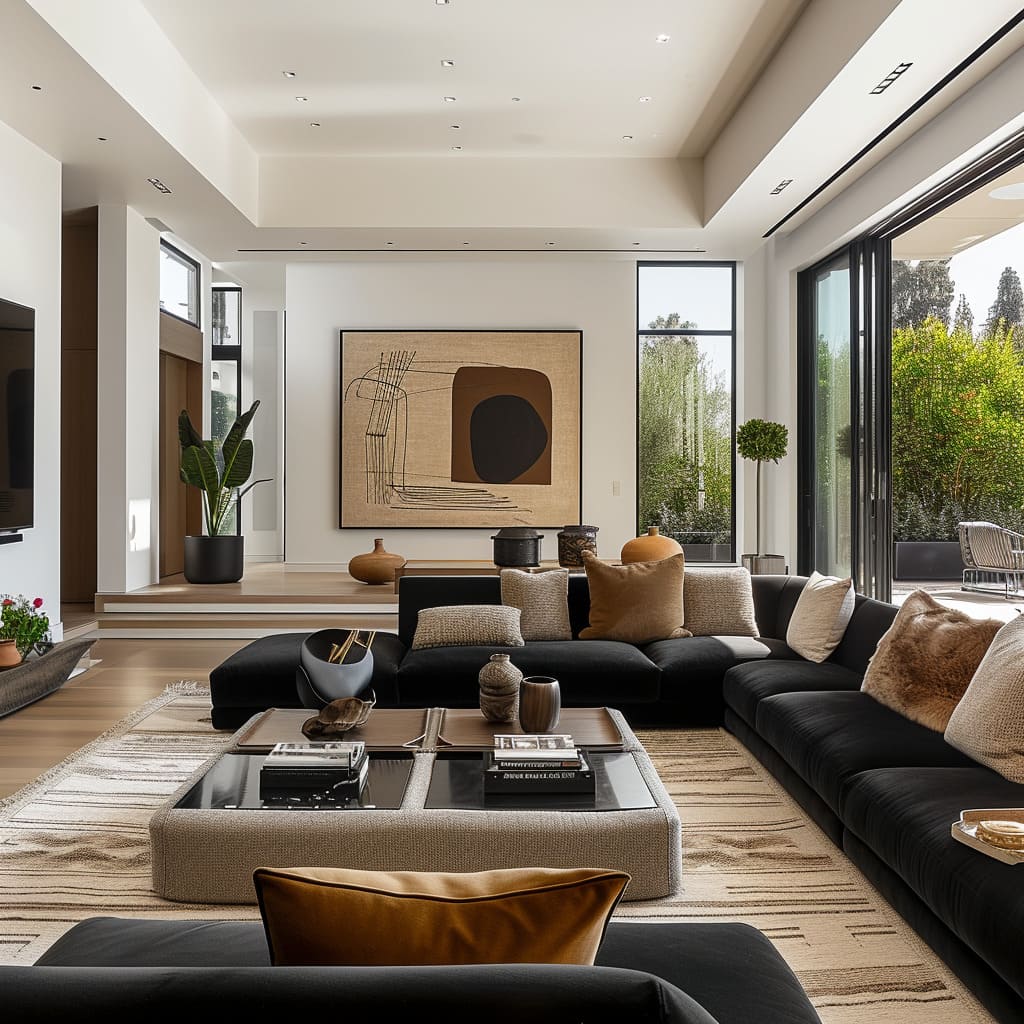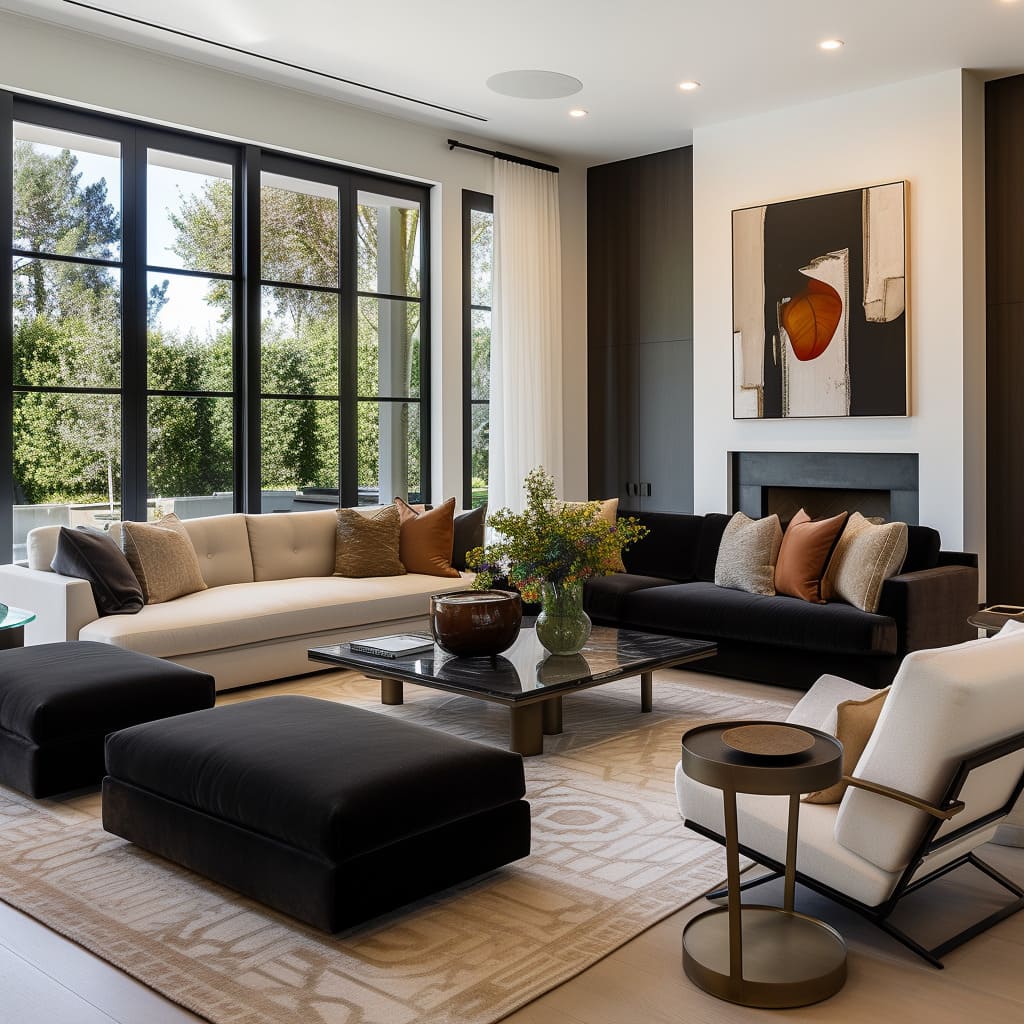In the field of interior design, the essence of a space is not just defined by its furniture or layout, but by the symphony of elements that come together to create an atmosphere that is as aesthetically pleasing as it is comfortable. Modern luxury living rooms stand as a testament to this design philosophy, showcasing a blend of neutral color palettes, contemporary furniture, and thoughtful accessorization.
This article delves into the key features of such living spaces, analyzing how each component—from the choice of lighting and layout to the use of indoor plants and architectural elements—contributes to the overarching sense of sophistication and harmony. As we dissect these impeccably designed interiors, we also offer practical advice on how to infuse these characteristics into your own home, transforming everyday living into an experience of luxury and style.
Join us as we explore the nuanced details that make these living rooms not just visually stunning, but also a blueprint for comfortable, high-end living.
The Key Ingredients of This Luxurious Living Room Style
Delving into the architectural genius of modern luxury living rooms, we uncover the myriad of elements that harmonize to form these exquisite spaces. From the subtle interplay of light and shadow to the strategic use of texture and color, each feature is a deliberate stroke on the designer’s canvas.
Below, we meticulously detail the integral components that culminate in the sophistication of high-end living, offering insights into their interplay and guidance on integrating these aspects into your own abode.
Color Palette
The rooms predominantly use a neutral color palette with a focus on black, white, and shades of gray. Accents are often provided by earth tones like brown, beige, rust, and burnt orange.
The neutrality of the background allows for a serene and calm base, where the mind can rest, and it also provides a versatile backdrop against which the more vibrant accents can stand out. These accents are not random but are carefully chosen to complement the natural light that flows through the large windows, reflecting off the high-gloss surfaces to create a warm and inviting space.
To incorporate such a color scheme in your own home, start with a base of neutral tones for your walls and large furniture pieces. This creates a blank canvas, allowing you to introduce color through accessories, cushions, and artwork.
Choose your accents in earthy tones that resonate with you personally, as these will be the colors that add personality to your space. Remember that a little can go a long way; a few well-placed items in rust or burnt orange can lift an entire room without overwhelming it.
Furniture
The furniture selection leans towards contemporary, with clean lines and a mix of textures. Low-profile sofas and sectionals in contrasting colors (often black and white) are staples, accompanied by unique statement chairs and oversized ottomans or poufs.
The furniture is not only aesthetically pleasing but also crafted to invite comfort, with plush cushions and soft, enveloping forms. The contrast in colors serves not just a visual purpose but also delineates spaces within the larger room, creating distinct areas for lounging, conversation, or viewing entertainment.
When selecting furniture for a modern luxury interior, aim for pieces that offer both form and function. Look for sofas with a lower height to maintain the openness of the space.
Add in chairs that make a statement—these can be in bold shapes or with distinctive fabrics that add texture to the room. Ottomans and poufs can be used for extra seating or as an informal table surface, so choose versatile pieces that can serve multiple purposes.
Materials
There’s a luxurious use of materials, such as plush fabrics for upholstery, smooth and shiny surfaces for tables, and richly textured rugs. Wood is often used as an accent material, adding warmth to the spaces.
This variety in materials is not accidental but a deliberate choice to engage the senses—velvet-like fabrics invite touch, while glossy tabletops catch the light and the eye. The juxtaposition of different textures creates a layered look that is complex and refined.
To emulate this material richness in your own space, mix materials thoughtfully. Combine a leather sofa with a velvet chair, or place a sleek metal coffee table atop a fluffy area rug.
Incorporate wooden elements to bring warmth and natural beauty, such as a wooden tray on a coffee table or a sculpted wooden piece as art. Each material should feel intentional and contribute to the overall balance of textures within the room.
Artwork
Each room features large-scale abstract artwork, which serves as a focal point and injects a sense of sophistication and personality. The artwork is chosen not just for its aesthetic appeal but also for its ability to evoke emotion and conversation.
The scale of the pieces is substantial, making them unmissable and integral to the design of the room, commanding attention and often setting the tone for the color accents used throughout.
Incorporating artwork into your living space is a deeply personal choice, but when aiming for a luxury modern look, consider scale and placement. Choose pieces that resonate with you and complement the room’s color scheme.
Large canvases can be a bold statement, or a series of smaller pieces can be arranged to create a gallery wall. Allow the art to stand out by giving it space—don’t crowd it with furniture or other decor items.
The right piece of art can tie a room together and showcase your personal style.
Lighting
A mix of lighting styles is present, including recessed ceiling lights, decorative pendant lights, and floor lamps, providing both functionality and ambiance. Strategic placement of lighting fixtures is key; for example, pendant lights often hover over key pieces like coffee tables or dining areas, creating intimate islands of light that draw people together.
Recessed lighting is used to wash the walls with a soft glow, highlighting the artwork and architectural features without creating a harsh glare. Floor lamps add a sculptural element to corners, as well as offering a focused source of light perfect for reading or accenting a particular section of the room.
To achieve this layered lighting effect in your own home, start with ambient lighting to set the overall mood of the room. This could be a combination of recessed ceiling lights and a central pendant fixture.
Add task lighting, such as floor or table lamps, in areas where you need focused light. Finally, consider accent lighting to showcase art or architectural features.
Dimmer switches are a great addition to control the intensity of light and can help to create different atmospheres within the same space.
Layout
The layout of the furniture promotes conversation, with sofas and chairs facing each other. The spaces are open and airy, with high ceilings and large windows that let in plenty of natural light.
This intentional arrangement fosters a welcoming atmosphere, encouraging social interaction. The furniture is often centered around a focal point, such as a fireplace or a television, with additional seating arranged in such a way that the room feels balanced and cohesive.
Pathways are left clear to allow for easy movement through the space, which also contributes to a sense of openness and flow.
For a living room layout that encourages conversation, place your primary seating area so that sofas and chairs are facing each other, or at right angles. Ensure there is enough space between furniture pieces for a comfortable flow of traffic.
Use area rugs to define smaller vignettes within the larger room, and avoid pushing all your furniture up against the walls, as this can make a room feel disconnected. Think about the natural pathways from one room to another and arrange your furniture to accommodate this flow.
Accessories
Decorative accessories are carefully curated to add character without clutter. These include books, bowls, vases, and sculptures, often with a handcrafted or bespoke quality.
Each item seems to have been chosen for its ability to complement the room’s color palette or for its textural contrast. Groupings of accessories are often displayed in odd numbers, particularly in threes, which is visually pleasing and creates a sense of organic asymmetry.
The placement is precise, allowing each piece to be seen and appreciated without overwhelming the space.
When selecting accessories for your living space, choose pieces that have a personal meaning or artistic value to you. Consider the scale of the accessories in relation to the furniture and the space itself; large rooms can handle larger pieces, whereas a smaller room may require more diminutive objects.
Arrange them in a way that creates balance and harmony. Use trays or books to group smaller items together, and leave some negative space on shelves and tables to let each accessory stand out.
Flooring
The floors are typically hardwood or tiled, providing a sleek and easy-to-maintain base that contrasts with the soft area rugs. The choice of flooring not only complements the minimalist aesthetic but also serves a practical purpose.
Hard surfaces are easier to clean and maintain, and they can help to reflect light, contributing to the overall brightness of the room. Area rugs are used not just for comfort underfoot but also to delineate different areas within the open-plan space, providing a visual anchor for the furniture.
Incorporate this feature into your home by selecting high-quality hardwood or tile for your floors, which will serve as a timeless and durable foundation for your design. Choose an area rug that complements your furniture and adds a layer of texture or color to the room.
Ensure the rug is large enough to fit under the main pieces of furniture to create a cohesive look. Regular maintenance, such as sweeping or vacuuming, will keep your floors looking their best and contribute to the overall clean and sophisticated aesthetic of your space.
Indoor Plants
Plants are used to bring a touch of nature indoors, which adds to the relaxed yet refined ambiance of the living spaces. In the article images, plants range from small, delicate tabletop arrangements to larger, more sculptural pieces that can stand on the floor and command attention.
They are positioned to create a natural flow and connection between the indoor and outdoor spaces, with leafy greens contrasting beautifully against the neutral color palette of the rooms. Notably, the plants chosen vary in texture and height, adding to the dynamic visual interest of the spaces.
To integrate plants into your interior, consider the lighting and climate of your room. Use larger plants in corners to soften the angles and create a more organic feel.
Smaller plants can be used on shelves or tables to add a fresh burst of life. Think about the pots as well; choose styles that match your decor for a more cohesive look.
Remember to consider the care requirements of each plant to ensure they thrive in your living space.
Architectural Elements
Attention to architectural detail is evident, with features like fireplaces, wall insets, and contrasting wall materials (such as painted walls versus stone or wood panels). The images showcase fireplaces not just as a source of warmth but as architectural focal points, often extending from floor to ceiling and clad in materials that stand out from the surrounding walls.
Wall insets provide the perfect niche for decorative items or firewood, integrating storage into the design in an aesthetically pleasing way.
To emphasize architectural elements in your space, focus on creating contrasts. If you have a fireplace, consider highlighting it by using a different material or color than the rest of the room.
Use wall insets to display art or collections, which can add depth and interest to your walls. Mixing materials like stone, wood, and paint can create a rich tapestry of surfaces that draw the eye and invite touch.
Outdoor Integration
Where visible, there is a seamless transition between the indoor spaces and the outdoors, with large windows or sliding doors opening up to exterior views and gardens, thus expanding the living space and bringing the outside in. The design maximizes natural light and views, with the outdoor scenery becoming a living artwork that changes with the seasons.
Furniture is often positioned to take advantage of these views, blurring the lines between inside and outside.
To achieve a similar connection with the outdoors, arrange your living space to face windows or glass doors. Use minimal window treatments to allow for unobstructed views, or choose sheer fabrics that let in light while providing privacy.
Ensure that the style and color of your outdoor furniture and decor complement the interior to enhance the flow between the two spaces.
Texture Play
There’s a deliberate play of textures across various elements, from soft throw pillows and shaggy rugs to smoother leather and metal finishes. This interplay is critical to the sensory experience of the room, encouraging interaction and adding depth.
The juxtaposition of matte and shiny, rough and smooth, creates a dynamic environment that is visually and tactilely engaging.
Incorporate a variety of textures in your home by mixing materials like wool, silk, leather, metal, and wood. Use throws and pillows on sofas to add comfort and visual warmth.
Consider the touch as well as the look of surfaces; for example, a rough-textured rug underfoot can contrast nicely with the smooth leather of a sofa.
Symmetry and Geometry
The design often employs symmetrical arrangements and geometric forms, which contribute to a balanced and harmonious look. The images display a clear intention to create order and structure within the space.
Furniture is arranged in pairs and aligned with architectural features, and geometric shapes are echoed in artwork, rugs, and even the shape of furniture and accessories.
To implement symmetry and geometry in your design, start with the larger pieces of furniture and ensure they are balanced within the space. Use geometric patterns in your decor to create rhythm and repetition.
However, it’s important to break the symmetry occasionally with an unexpected element to keep the space dynamic and interesting.
The Final Stroke in The Luxury Living Room Design
In conclusion, the modern luxury living room is more than just a space—it’s a carefully curated experience that balances form, function, and fashion. The components that make up such rooms, from the harmonious color palettes and thoughtful lighting to the intentional textures and architectural details, all serve a purpose.
They create an environment that is not only visually stunning but also inviting and livable. As we’ve explored the intricate details of these design features, it’s evident that the true essence of luxury lies in the subtleties—the way natural light dances across a room, the dialogue between indoor and outdoor spaces, and the personal touches that make a space uniquely yours.
Whether you’re looking to revamp your living area or just appreciate the nuances of interior design, the modern luxury living room offers endless inspiration. By adopting even a few of these design principles, you can infuse a sense of elevated elegance into your own home.

